
S&P 500
New highs this week again from the S&P have support from rising market breadth.
The Elliott wave count provides targets.
Summary: The bull market is expected to continue and corrections are expected to be shallow. A new target for the next reasonable consolidation or pullback to begin is at 3,148.
The biggest picture, Grand Super Cycle analysis, is here.
Monthly charts were last published here, with video here. There are two further alternate monthly charts here. Video is here.
ELLIOTT WAVE COUNTS
The two Elliott wave counts below will be labelled First and Second. They may be about of even probability. When the fifth wave currently unfolding on weekly charts may be complete, then these two wave counts will diverge on the severity of the expected following bear market. To see an illustration of this future divergence monthly charts should be viewed.
FIRST WAVE COUNT
WEEKLY CHART
The basic Elliott wave structure consists of a five wave structure up followed by a three wave structure down (for a bull market). This wave count sees the bull market beginning in March 2009 as an incomplete five wave impulse and now within the last fifth wave, which is labelled cycle wave V. This impulse is best viewed on monthly charts. The weekly chart focusses on the end of it.
Elliott wave is fractal. This fifth wave labelled cycle wave V may end a larger fifth wave labelled Super Cycle wave (V), which may end a larger first wave labelled Grand Super Cycle wave I.
The teal Elliott channel is drawn using Elliott’s first technique about the impulse of Super Cycle wave (V). Draw the first trend line from the end of cycle wave I (off to the left of the chart, the weekly candlestick beginning 30th November 2014) to the end of cycle wave III, then place a parallel copy on the end of cycle wave II. This channel perfectly shows where cycle wave IV ended at support. The strongest portion of cycle wave III, the end of primary wave 3, overshoots the upper edge of the channel. This is a typical look for a third wave and suggests the channel is drawn correctly and the way the impulse is counted is correct.
Within Super Cycle wave (V), cycle wave III is shorter than cycle wave I. A core Elliott wave rule states that a third wave may never be the shortest. For this rule to be met in this instance, cycle wave V may not be longer in length than cycle wave III. This limit is at 3,477.39.
The structure of cycle wave V is focussed on at the daily chart level below.
Within cycle wave V, primary waves 1 and 2 may now be complete. Within primary wave 3, no second wave correction may move beyond its start below 2,728.81.
In historic analysis, two further monthly charts have been published that do not have a limit to upwards movement and are more bullish than this wave count. Members are encouraged to consider those possibilities (links below summary) alongside the wave counts presented on a daily and weekly basis.
Daily charts below will now focus on price movement from the high of primary wave 1.
DAILY CHART
Cycle wave V must subdivide as a five wave motive structure. Within that five wave structure, primary waves 1 and 2 may be complete.
Primary wave 3 must move above the end of primary wave 1 (this rule has now been met). Primary wave 3 may only subdivide as an impulse.
Within the impulse of primary wave 3, intermediate waves (1) and (2) may both be complete.
Intermediate wave (3) may be about halfway through. Intermediate wave (3) may only subdivide as an impulse. Within the impulse, minor waves 1 and 2 may be complete. Within minor wave 3, no second wave correction may move beyond its start below 2,963.44.
When primary wave 3 is over, then primary wave 4 may be a shallow sideways consolidation.
Thereafter, primary wave 5 should move above the end of primary wave 3 to avoid a truncation.
Primary wave 1 lasted 86 sessions, 3 short of a Fibonacci 89. Primary wave 2 lasted 22 sessions, 1 longer than a Fibonacci 21. Primary wave 3 may end about a Fibonacci 55 sessions, give or take two or three sessions either side. This is a rough guideline only.
So far primary wave 3 has lasted 28 sessions.
Draw the best fit channel to contain all of intermediate wave (3). Draw the first trend line from the end of intermediate wave (1) to the end of minor wave 1, then place a parallel copy on the low labelled intermediate wave (2).
SECOND WAVE COUNT
WEEKLY CHART
This weekly chart is almost identical to the first weekly chart, with the sole exception being the degree of labelling.
This weekly chart moves the degree of labelling for the impulse beginning in March 2009 all down one degree. This difference is best viewed on monthly charts.
The impulse is still viewed as nearing an end; a fifth wave is still seen as needing to complete higher. This wave count labels it primary wave 5.
TECHNICAL ANALYSIS
WEEKLY CHART
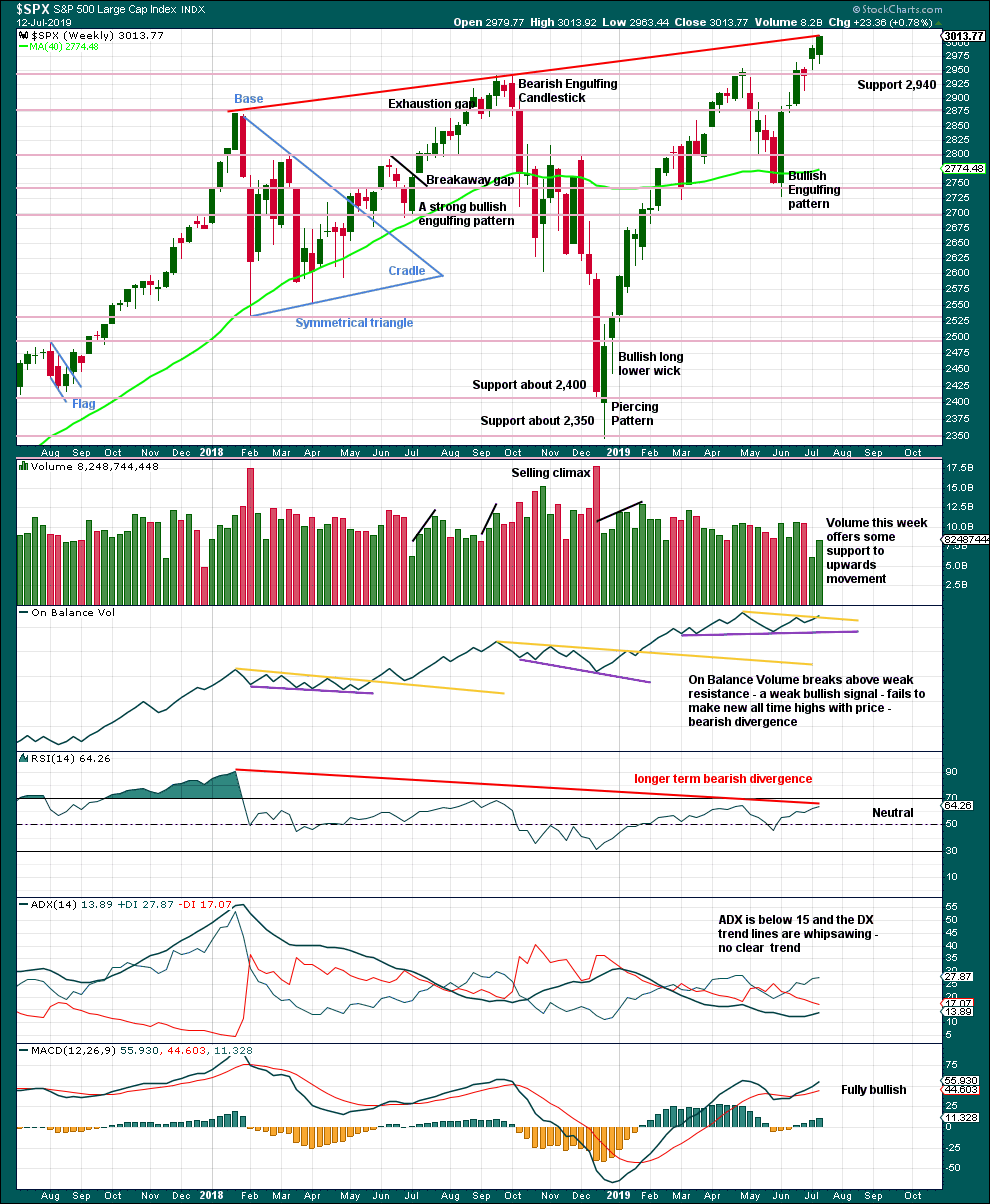
Click chart to enlarge. Chart courtesy of StockCharts.com.
Price has closed near the high for the week and volume supports upwards movement. This suggests more upwards movement next week.
Longer-term bearish divergence between price and RSI fits the Elliott wave count: the most extreme reading from RSI corresponds with the end of a third wave, and now a fifth wave at cycle or primary degree exhibits some weakness compared to the third wave.
DAILY CHART
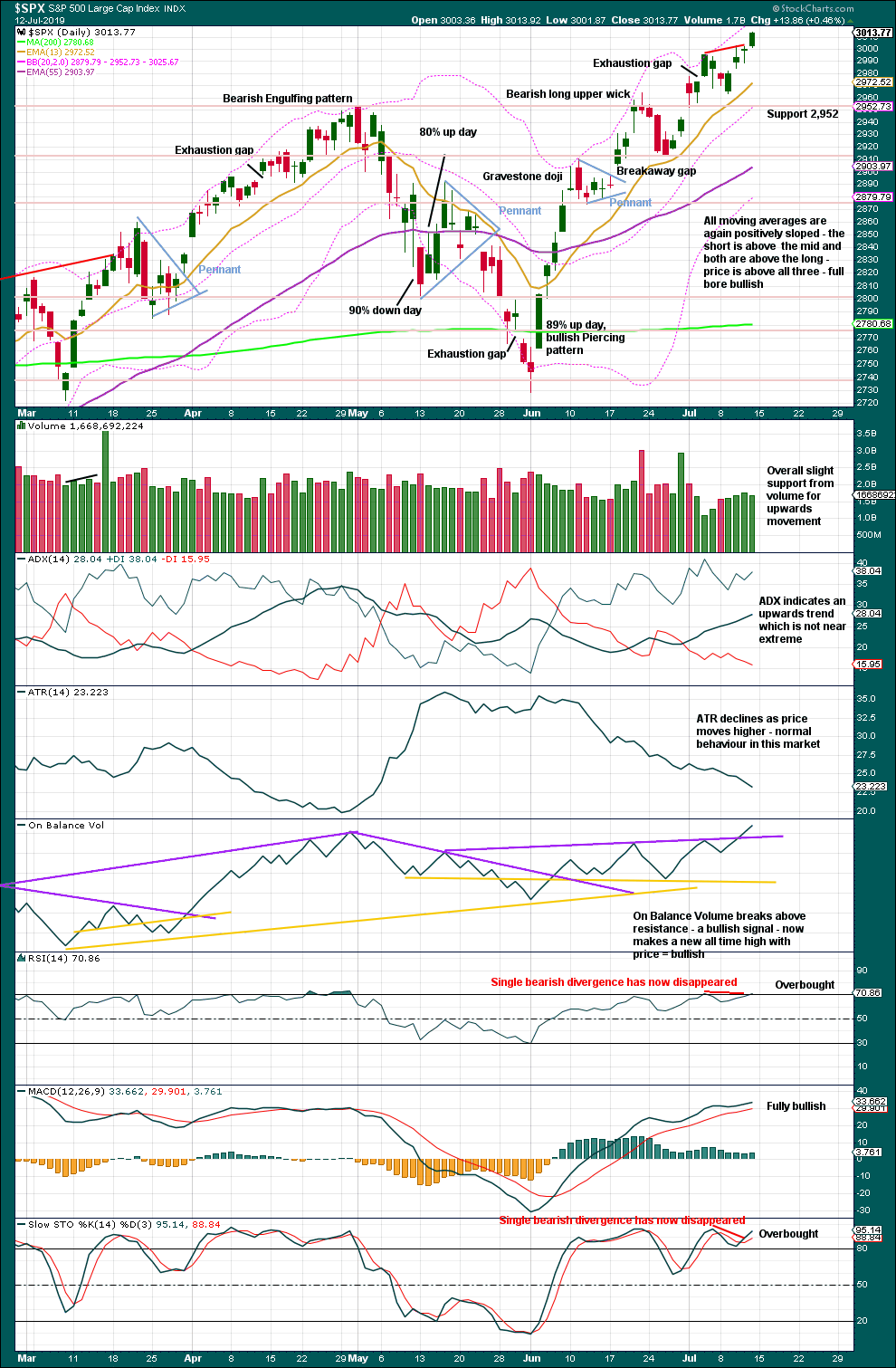
Click chart to enlarge. Chart courtesy of StockCharts.com.
A close near the high for Friday suggests more upwards movement next week.
There is an upwards trend in place, which is not yet extreme, and there is room for the trend to continue a fair amount further. When this market trends, RSI and Stochastics may reach overbought and may remain there for extended periods of time. Sometimes divergence may develop and then simply disappear.
Look for resistance at round number pivots or Elliott wave targets.
BREADTH – AD LINE
WEEKLY CHART
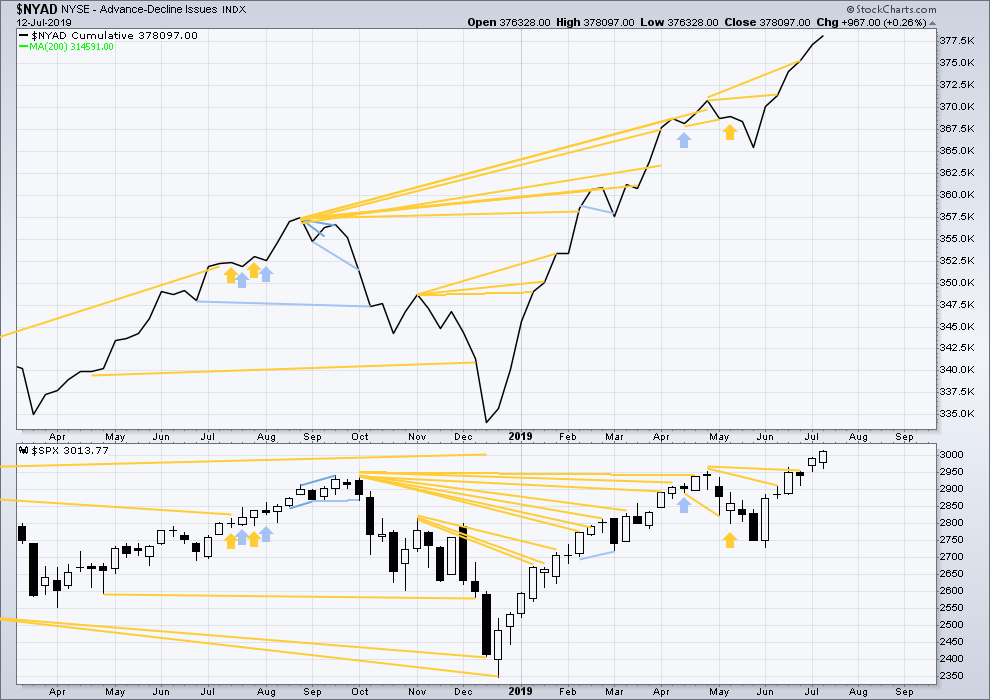
Click chart to enlarge. Chart courtesy of StockCharts.com. So that colour blind members are included, bearish signals
will be noted with blue and bullish signals with yellow.
Bear markets from the Great Depression and onwards have been preceded by an average minimum of 4 months divergence between price and the AD line with only two exceptions in 1946 and 1976. With the AD line making new all time highs again this week, the end of this bull market and the start of a new bear market is very likely a minimum of 4 months away, which is mid November 2019.
In all bear markets in the last 90 years there is some positive correlation (0.6022) between the length of bearish divergence and the depth of the following bear market. No to little divergence is correlated with more shallow bear markets. Longer divergence is correlated with deeper bear markets.
If a bear market does develop here, it comes after no bearish divergence. It would therefore more likely be shallow.
This week the AD line again makes new all time highs with price. Upwards movement has good support from rising market breadth, indicating a healthy bull market.
Mid caps remain below their all time high of 24th April 2019, and small caps remain below their all time high of 25th February 2019. Weakness is beginning to develop in small caps and mid caps. This is normal behaviour during the later stages of a bull market, and may be expected to develop further before the bull market may end. Tops are a process and that process may last months to even years.
DAILY CHART
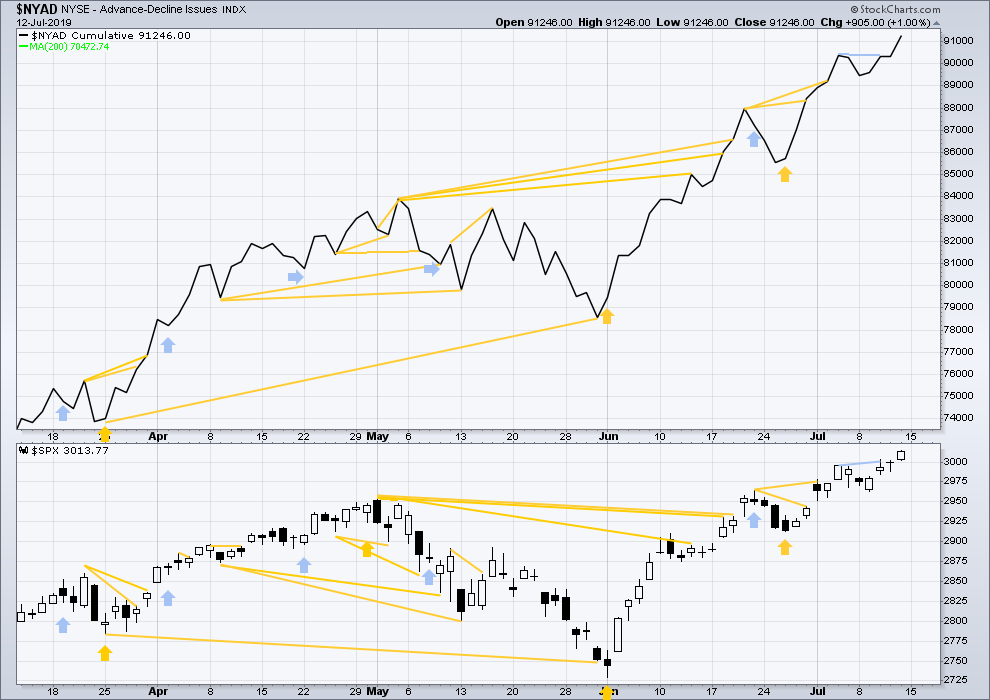
Click chart to enlarge. Chart courtesy of StockCharts.com. So that colour blind members are included, bearish signals
will be noted with blue and bullish signals with yellow.
Breadth should be read as a leading indicator.
New all time highs from both price and the AD line on Friday indicate the bull market has support from rising market breadth. This is bullish.
VOLATILITY – INVERTED VIX CHART
WEEKLY CHART

Click chart to enlarge. Chart courtesy of StockCharts.com. So that colour blind members are included, bearish signals
will be noted with blue and bullish signals with yellow.
The all time high for inverted VIX (which is the same as the low for VIX) was on 30th October 2017. There is now nearly one year and eight months of bearish divergence between price and inverted VIX.
The rise in price is not coming with a normal corresponding decline in VIX; VIX remains elevated. This long-term divergence is bearish and may yet develop further as the bull market matures.
This divergence may be an early warning, a part of the process of a top developing that may take years. It may not be useful in timing a trend change.
DAILY CHART
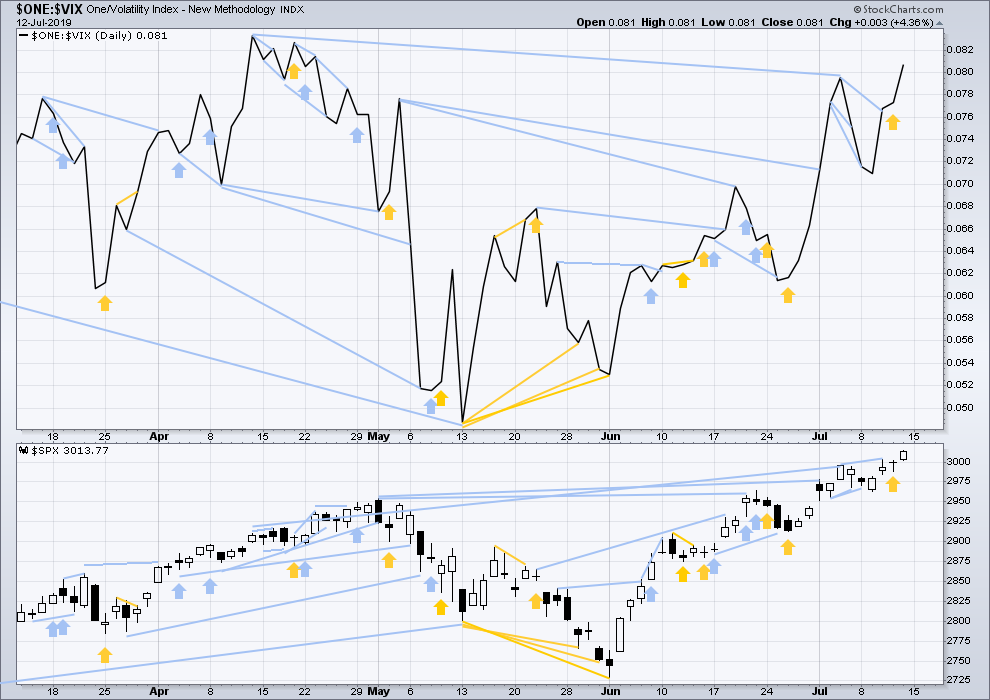
Click chart to enlarge. Chart courtesy of StockCharts.com. So that colour blind members are included, bearish signals
will be noted with blue and bullish signals with yellow.
Short-term bearish divergence has not been followed by any downwards movement in price, so it is considered to have failed.
Mid and longer-term bearish divergence between price and inverted VIX remains.
DOW THEORY
Dow Theory confirmed a bear market in December 2018. This does not necessarily mean a bear market at Grand Super Cycle degree though; Dow Theory makes no comment on Elliott wave counts. On the 25th of August 2015 Dow Theory also confirmed a bear market. The Elliott wave count sees that as part of cycle wave II. After Dow Theory confirmation of a bear market in August 2015, price went on to make new all time highs and the bull market continued.
DJIA: 23,344.52 – a close on the 19th of December at 23,284.97 confirms a bear market.
DJT: 9,806.79 – price has closed below this point on the 13th of December.
S&P500: 2,532.69 – a close on the 19th of December at 2,506.96 provides support to a bear market conclusion.
Nasdaq: 6,630.67 – a close on the 19th of December at 6,618.86 provides support to a bear market conclusion.
With all the indices having moved higher following a Dow Theory bear market confirmation, Dow Theory would confirm a bull market if the following highs are made:
DJIA: 26,951.81 – a close above this point has been made on the 3rd of July 2019.
DJT: 11,623.58 – to date DJT has failed to confirm an ongoing bull market.
S&P500: 2,940.91 – a close above this point was made on the 29th of April 2019.
Nasdaq: 8,133.30 – a close above this point was made on the 26th of April 2019.
GOLD
A pennant pattern may be completing on the daily chart. A target is calculated from the flag pole.
Summary: After the breakout from multi year resistance on 20th June, it was expected that price would curve around and back test support about 1,360 to 1,375. That test of support may be very shallow reaching down to only about 1,380. It may end on Monday with an upwards breakout.
There are two Elliott wave scenarios in this analysis (published below in this order):
1. The bear market continues: the breakout was false but incomplete. One final high to 1,452 or 1,489 may unfold before a multi year trend change and a new downwards wave to new lows.
2. A bull market is underway: this back test of support is a fourth wave correction. The target for the mid term is 1,565. It is this scenario which currently has the most support from classic technical analysis, but it still has the biggest problem in terms of Elliott wave structure.
If price does break out of the current pennant pattern upwards, then a classic analysis target is at 1,537.
Grand SuperCycle analysis is here.
Last monthly charts are here.
Overall, the bearish wave counts still have a higher probability based upon Elliott wave structures. However, it would be best to leave price to invalidate either the bullish or bearish scenario before having confidence in which is correct.
BEARISH ELLIOTT WAVE COUNTS
FIRST WEEKLY CHART
It remains possible that the bear market for Gold may yet continue. It is possible that cycle wave b may be nearing completion. Cycle wave b may be a double zigzag.
Double zigzags are common structures, but within them their X waves are almost always single zigzags that are relatively brief and shallow. However, this wave count sees primary wave X as a complete double combination: zigzag – X – expanded flat.
An X wave may occasionally subdivide as a multiple. In a multiple the maximum number of corrective structures is three: W, Y and Z. To label any one of W, Y or Z as a multiple would violate the Elliott wave rule. Here, the rule is met.
Primary wave Y may be an incomplete zigzag. The purpose of a second zigzag in a double zigzag is to deepen the correction when the first zigzag does not move price far enough. This purpose has been achieved.
A new low now by any amount at any time frame below 1,346.45 would invalidate the bullish wave count below and provide some confidence in this wave count.
DAILY CHART
This chart focusses on the impulse of intermediate wave (C).
Intermediate wave (C) may be an incomplete impulse. The last several sessions may be a triangle for minor wave 4.
The target for intermediate wave (C) is calculated for it to reach equality in length with intermediate wave (A).
A second higher target is calculated at primary degree for primary wave Y to reach equality in length with primary wave W. If price reaches the first target and either the structure of minor wave 5 is incomplete or price keeps rising, then the second target may be used.
After cycle wave b may be complete, this wave count would require a new low below 1,346.45 for confidence.
Note: The price spike down to 1,378 on the daily chart for the 11th of July is highly suspicious because it is not visible on time frames below daily. I have contacted Barchart to open a support ticket for this problem, which I expect this will be fixed on Monday. The price spike is ignored in this analysis because it is not visible on time frames below daily.
The prior bearish wave count, which viewed a high in place, has now substantial problems in terms of structure on the hourly chart, and it lacks support from classic technical analysis. That wave count is now discarded.
BULLISH ELLIOTT WAVE COUNT
WEEKLY CHART
This wave count sees the the bear market complete at the last major low for Gold in November 2015.
If Gold is in a new bull market, then it should begin with a five wave structure upwards on the weekly chart. However, the biggest problem with this wave count is the structure labelled cycle wave I because this wave count must see it as a five wave structure, but it looks more like a three wave structure.
Commodities often exhibit swift strong fifth waves that force the fourth wave corrections coming just prior and just after to be more brief and shallow than their counterpart second waves. It is unusual for a commodity to exhibit a quick second wave and a more time consuming fourth wave, and this is how cycle wave I is labelled. This wave count still suffers from this very substantial problem, and for this reason two bearish wave counts are still considered above as they have a better fit in terms of Elliott wave structure.
Cycle wave II subdivides well as a double combination: zigzag – X – expanded flat.
Cycle wave III may have begun. Within cycle wave III, primary waves 1 and 2 may now be complete. If it continues lower as a double zigzag, then primary wave 2 may not move beyond the start of primary wave 1 below 1,160.75.
Cycle wave III so far for this wave count would have been underway now for 45 weeks. It may be beginning to exhibit some support from volume and increasing ATR. If this increase continues, then this wave count would have some support from technical analysis.
Draw an acceleration channel about primary waves 1 and 2: draw the first trend line from the end of primary wave 1 to the last high, then place a parallel copy on the end of primary wave 2. Keep redrawing the channel as price continues higher. When primary wave 3 is complete, then this channel would be drawn using Elliott’s first technique about the impulse. The lower edge may provide support.
Primary wave 4 may not move into primary wave 1 price territory below 1,346.45.
DAILY CHART
This daily chart focusses on the impulse of primary wave 3.
Primary wave 3 may only subdivide as an impulse. Primary wave 3 has now moved above the end of primary wave 1, meeting a core Elliott wave rule.
When it arrives, primary wave 4 may not move into primary wave 1 price territory below 1,346.45.
Intermediate wave (5) may exhibit further strength. The target for primary wave 3 is calculated using the most common Fibonacci ratio to primary wave 1.
The structure of primary wave 3 as an incomplete impulse for this wave count is seen in exactly the same way as the incomplete impulse for intermediate wave (C) in the bearish daily chart. Both wave counts view a fourth wave triangle unfolding sideways. This bullish wave count sees the triangle as intermediate wave (4).
Look out now for the possibility of another blow off top as intermediate wave (5) to end primary wave 3 comes to an end.
TECHNICAL ANALYSIS
MONTHLY CHART
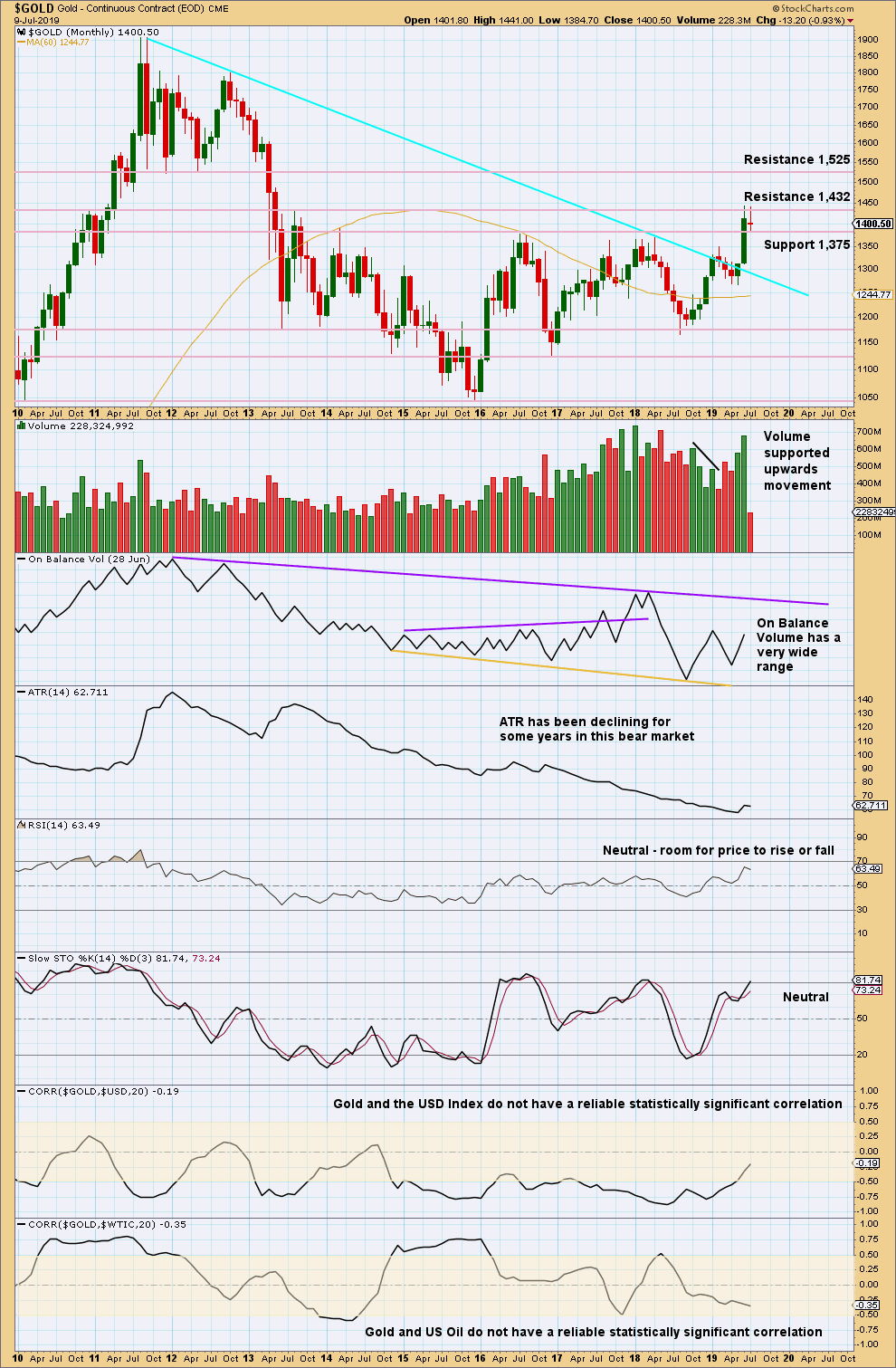
Click chart to enlarge. Chart courtesy of StockCharts.com.
Gold has effected an upwards breakout above multi-year resistance and above the cyan bear market trend line. Look for next resistance identified on the chart.
WEEKLY CHART

Click chart to enlarge. Chart courtesy of StockCharts.com.
Gold has broken out of a multi-year consolidation, which saw resistance about 1,375. The breakout has support from volume, so confidence may be had in it.
Price now has some strength with rising ATR. Conditions remain overbought. The pullback so far has not relieved extreme conditions and has lasted only two weeks.
Support about 1,375 continues to hold.
When Gold has a strong trend, conditions may reach extreme and may remain there for some time while the trend continues and price moves a substantial distance.
DAILY CHART
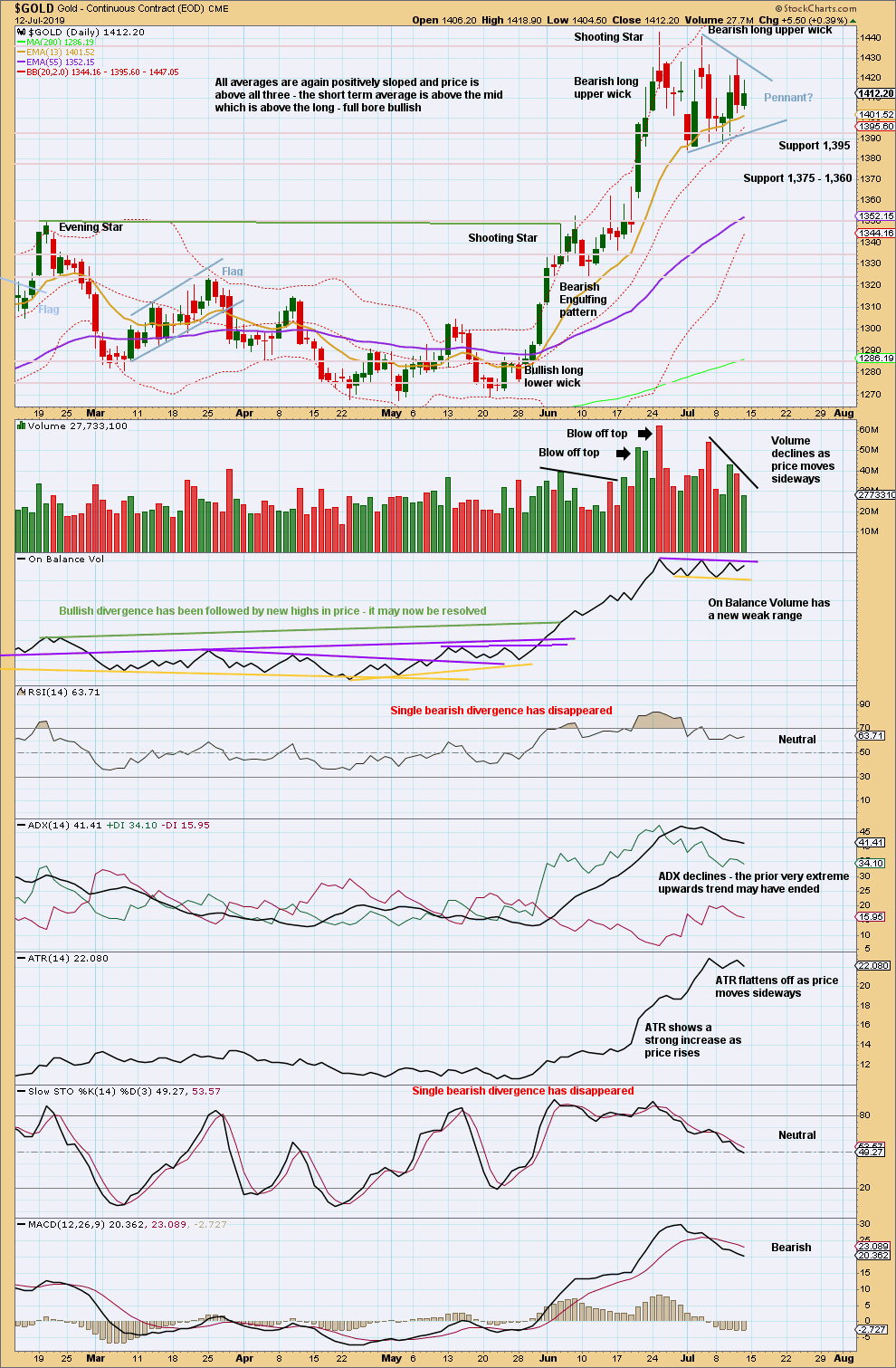
Click chart to enlarge. Chart courtesy of StockCharts.com.
It is common to see price curve down and back test support at prior resistance after a breakout. This is what is happening, although the test of support is shallow.
A pennant pattern may be forming. These are reliable continuation patterns. The best performing pennants and flags complete within 15 sessions. So far this one has lasted 12. The target from the flag pole would be at 1,537.
Consolidation of the last several sessions after the breakout has now lasted long enough to bring conditions down from extreme. There is again room for price to rise.
At this stage, a signal from On Balance Volume should be taken very seriously. If On Balance Volume breaks out of its current range, then it may precede price.
This chart supports a bullish outlook for the short to mid term.
GDX WEEKLY CHART
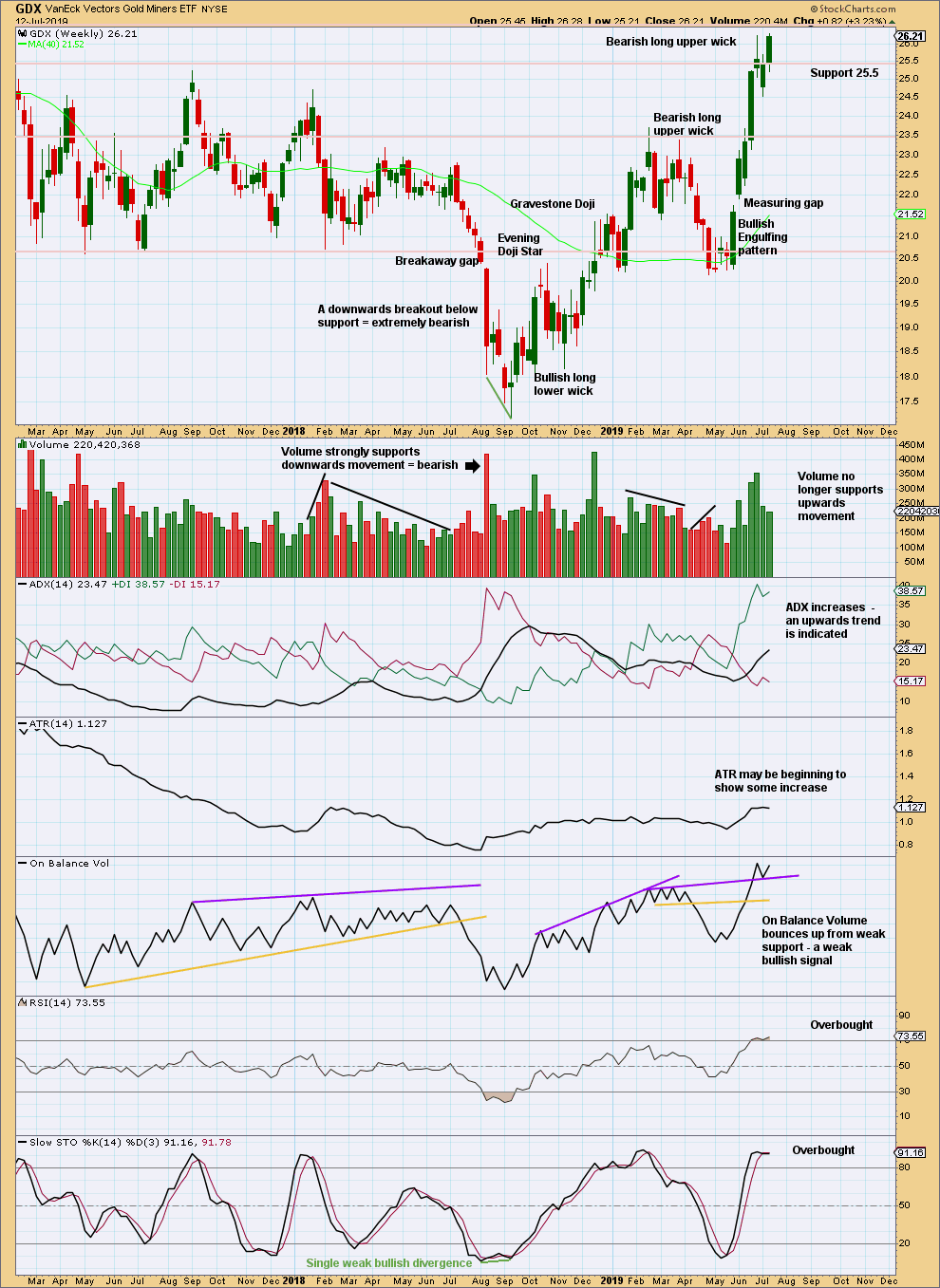
Click chart to enlarge. Chart courtesy of StockCharts.com.
The upwards trend continues, but conditions are now overbought. This can continue for a while during a strong trend. At this stage, there are no signs of a reversal.
This week price has closed near the high. This is bullish, suggesting more upwards movement next week.
Weak volume is a slight concern.
GDX DAILY CHART
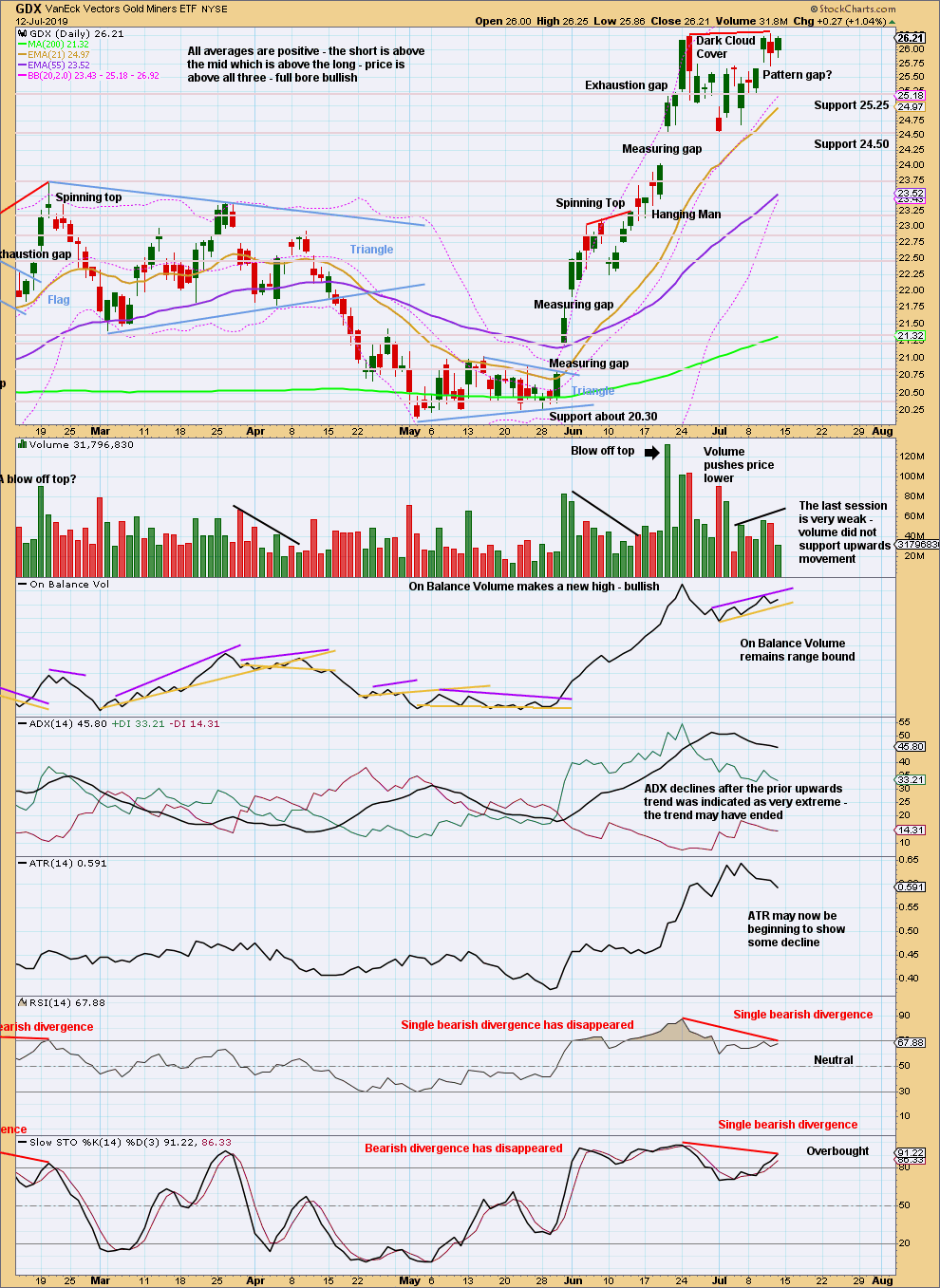
Click chart to enlarge. Chart courtesy of StockCharts.com.
The measuring gap remains open as long as price remains above 24.03. Closure of this gap would be a significant bearish signal.
The last gap is within the current consolidation zone, so it is most likely a pattern gap. These are usually closed.
The prior upwards trend reached very extreme. Price has been consolidating with a slight upwards bias this week, and there is now bearish divergence between price and both of RSI and Stochastics. However, divergence is not always reliable; sometimes it simply disappears.
There is still no evidence of a trend change in a bearish candlestick pattern or a new low. While the last swing low at 24.53 remains intact, it would be safest to assume the upwards trend may not be over (despite ADX) but to exercise extreme caution as it is overextended and may end at any time.
US OIL
Upwards movement for the week was expected to a target zone at 60.53 to 61.74. The high for the week at 60.93 fits this expectation exactly.
Summary: The bounce may end now very early next week within the target zone from 60.53 to 61.74. If price comes up to touch the upper edge of the maroon channel, then it should find strong resistance there and end the bounce.
The larger trend most likely still remains down. The final target is calculated at 10.72.
A new bullish alternate wave count would have confidence above 66.59. At that stage, a target for a third wave to end would be at 89.80.
MAIN ELLIOTT WAVE COUNT
MONTHLY CHART
The basic Elliott wave structure is five steps forward and three steps back. This Elliott wave count expects that US Oil is still within a three steps back pattern, which began in July 2008. The Elliott wave count expects that the bear market for US Oil continues.
This Elliott wave corrective structure is a double zigzag, which is a fairly common structure. The correction is labelled Super Cycle wave (II).
The first zigzag in the double is complete and labelled cycle wave y. The double is joined by a three in the opposite direction labelled cycle wave x, which subdivides as a zigzag. The second zigzag in the double may now have begun, labelled cycle wave w.
The purpose of a second zigzag in a double zigzag is to deepen the correction when the first zigzag does not move price deep enough. To achieve this purpose cycle wave y may be expected to move reasonably below the end of cycle wave w at 26.06. The target calculated would see this expectation met.
Cycle wave y is expected to subdivide as a zigzag, which subdivides 5-3-5.
Cycle wave w lasted 7.6 years and cycle wave x lasted 2.7 years. Cycle wave y may be expected to last possibly about a Fibonacci 5 or 8 years.
If it continues higher, then primary wave B may not move beyond the start of primary wave A above 76.90.
WEEKLY CHART
This weekly chart shows all of cycle waves x and y so far.
Cycle wave y is expected to subdivide as a zigzag. A zigzag subdivides 5-3-5. Primary wave A must subdivide as a five wave structure if this wave count is correct.
Primary wave A may be a complete five wave impulse at the last low.
Primary wave B may now be a complete single zigzag at the last high.
Primary wave C may have just begun. Primary wave C must subdivide as a five wave structure.
Primary wave A lasted 12 weeks, just one short of a Fibonacci 13.
Primary wave C may be longer in time as well as price. If cycle wave y lasts a Fibonacci 5 years, then primary wave C within it may take as long as a Fibonacci 233 weeks.
Intermediate wave (1) within primary wave C may be a complete impulse. Intermediate wave (2) may not move beyond the start of intermediate wave (1) above 66.59.
Draw a channel about the zigzag of primary wave y using Elliott’s technique for a correction. Draw the first trend line from the start of primary wave A to the end of primary wave B, then place a parallel copy on the end of primary wave A. The upper edge of this channel may show where bounces along the way down find resistance. The lower edge of the channel may provide support.
If intermediate wave (2) does come up to touch the upper edge of the maroon channel, then that may offer an opportunity to join the downwards trend.
DAILY CHART
Note that monthly and weekly charts are on a semi-log scale, but this daily chart is on an arithmetic scale. This makes a slight difference to trend channels.
It is possible that intermediate wave (1) is complete. Minor wave 4 for this wave count exhibits some alternation to minor wave 2; minor wave 2 may be a relatively deep zigzag or flat, and minor wave 4 may be a more shallow zigzag.
Minor wave 5 ends with a slight 0.11 truncation.
Intermediate wave (2) would most likely unfold as a zigzag and may end either about the 0.618 Fibonacci ratio of intermediate wave (1) or about the upper edge of the maroon Elliott channel. Intermediate wave (2) may now end early next week.
Intermediate wave (2) may not move beyond the start of intermediate wave (1) above 66.59.
Within the zigzag of intermediate wave (2), minor wave A may be a complete five wave impulse and minor wave B may be a complete expanded flat.
The target zone may see intermediate wave (2) come up to resistance at the upper edge of the channel.
DAILY CHART – DETAIL
So that this main wave count may be compared to the alternate below, the detail of cycle wave x is shown on this daily chart.
This upwards wave fits best as a three wave zigzag. Within the zigzag, primary wave C is 3.73 short of 1.618 the length of primary wave A.
Primary wave C fits well as a five wave impulse. There is perfect alternation between the deep 0.82 double zigzag of intermediate wave (2) and the shallow 0.18 running contracting triangle of intermediate wave (4). The proportions between intermediate waves (2) and (4) are excellent: intermediate wave (2) lasted 86 sessions and intermediate wave (4) lasted 78 sessions.
Fibonacci Ratios within primary wave C are: there is no Fibonacci ratio between intermediate waves (3) and (1), and intermediate wave (5) is just 0.22 short of 0.618 the length of intermediate wave (1).
Fibonacci Ratios within intermediate wave (3) are: minor wave 3 is just 0.72 longer than 4.236 the length of minor wave 1, and minor wave 5 is just 0.56 longer than 0.618 the length of minor wave 3.
ALTERNATE ELLIOTT WAVE COUNT
MONTHLY CHART
It is possible that the bear market is over for Oil and a new bull market has begun.
For a bullish wave count for Oil, the upwards wave from the major low at 26.06 in February 2016 must be seen as a complete five wave impulse. This is labelled cycle wave I.
Cycle wave II may be a complete zigzag at 0.679 the depth of cycle wave I.
A target is calculated for cycle wave III to reach a common Fibonacci ratio to cycle wave I.
Within cycle wave III, no second wave correction may move beyond the start of its first wave below 42.37.
WEEKLY CHART
This weekly chart shows some detail of cycle wave I as a five wave impulse.
Cycle wave II does look best as a three. This is the only part of this wave count that has a better look than the main wave count, which sees this downwards wave as a five.
DAILY CHART
Primary wave 3 may only subdivide as an impulse. Within the impulse, intermediate wave (1) may be nearing completion.
Intermediate wave (2) may not move beyond the start of intermediate wave (1) below 50.61.
DAILY CHART – DETAIL
This daily chart shows all of cycle wave I as a five wave impulse.
Within the impulse, there is alternation between the relatively shallow 0.49 zigzag of primary wave 2 and the more shallow 0.18 running contracting triangle of primary wave 4. There is acceptable proportion: primary wave 2 lasted 39 sessions and primary wave 4 lasted 78 sessions (triangles tend to be more time consuming structures than zigzags).
Fibonacci Ratios within primary wave 3 are: intermediate wave (3) is just 1.10 short of 1.618 the length of intermediate wave (1), and intermediate wave (5) is 1.11 short of equality in length with intermediate wave (1).
Within primary wave 3, there is alternation between the deep 0.82 double zigzag of intermediate wave (2) and the shallow 0.35 zigzag of intermediate wave (4). However, the biggest problem with this wave count is the gross disproportion between intermediate waves (2) and (4): intermediate wave (2) lasted 82 sessions and intermediate wave (4) lasted just 11 sessions. This is possible: commodities do tend to exhibit quicker fourth waves than second within third wave impulses one degree higher.
TECHNICAL ANALYSIS
MONTHLY CHART
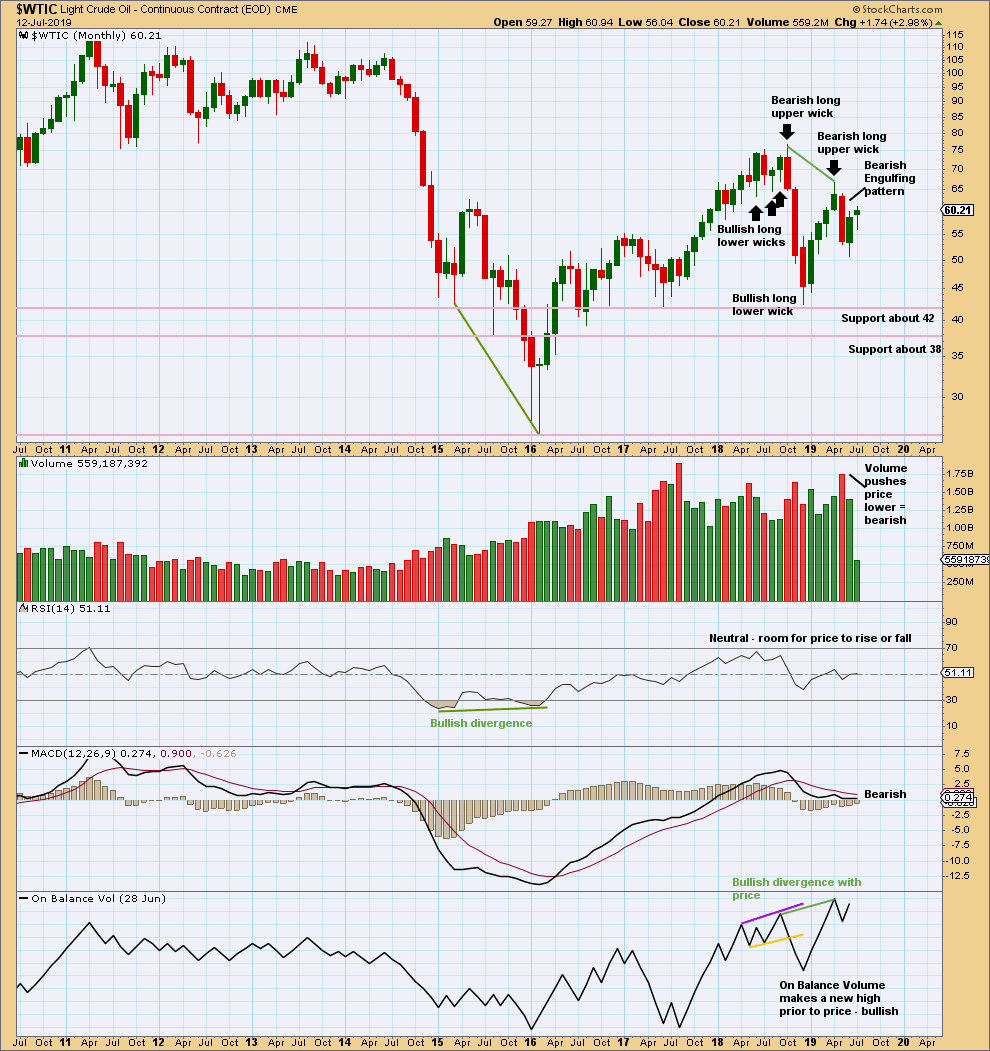
Click chart to enlarge. Chart courtesy of StockCharts.com.
May has closed with a strong Bearish Engulfing candlestick pattern, which has strong support from volume. This supports the main Elliott wave count.
June moved price lower with a lower low and a lower high, but the candlestick closed green and the balance of volume was upwards. Upwards movement within the month did not have support from volume. This also supports the main Elliott wave count.
Bullish divergence between price and On Balance Volume supports the alternate Elliott wave count.
WEEKLY CHART
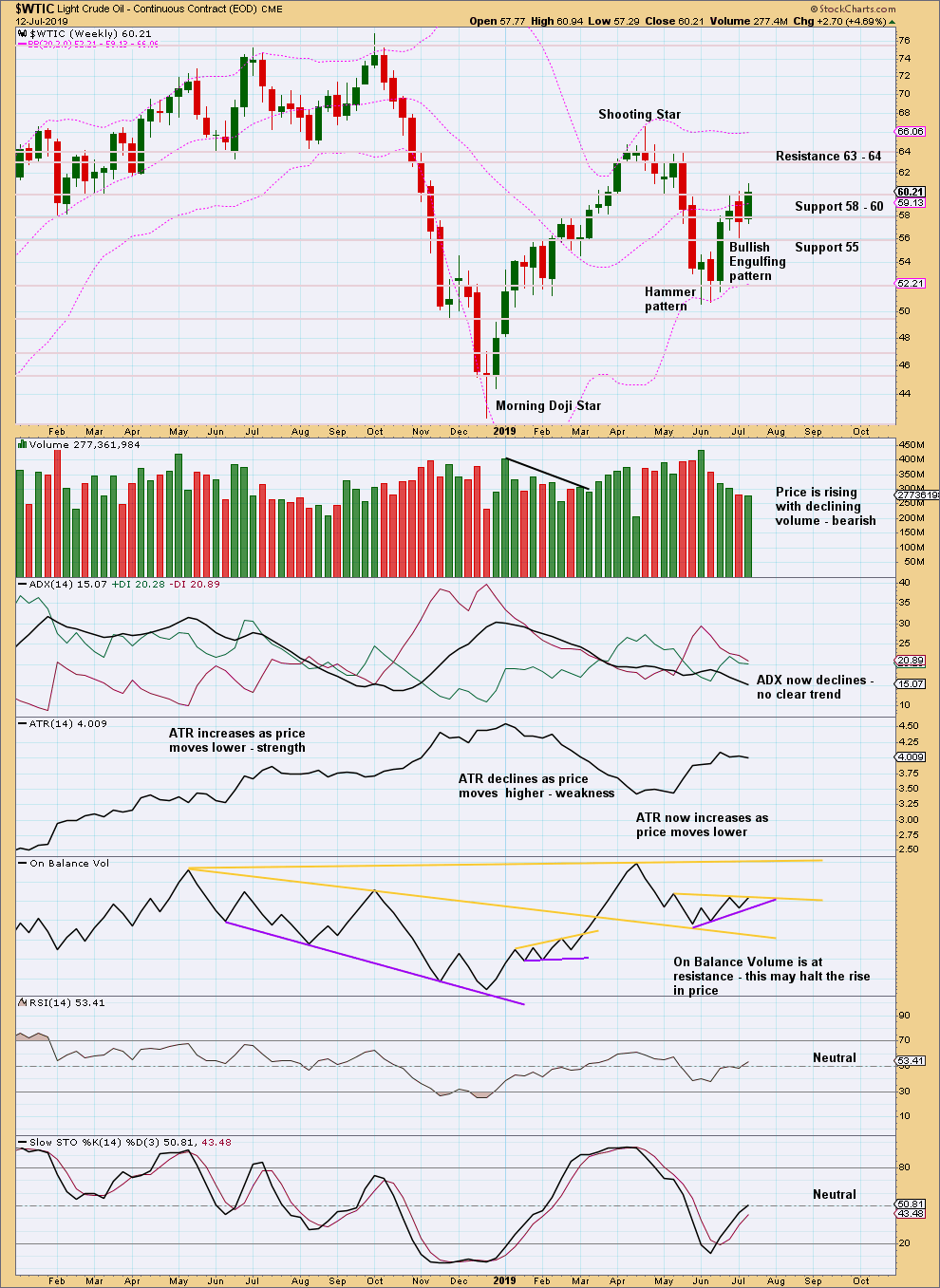
Click chart to enlarge. Chart courtesy of StockCharts.com.
Declining volume and flat ATR as price rises support the main Elliott wave count.
DAILY CHART
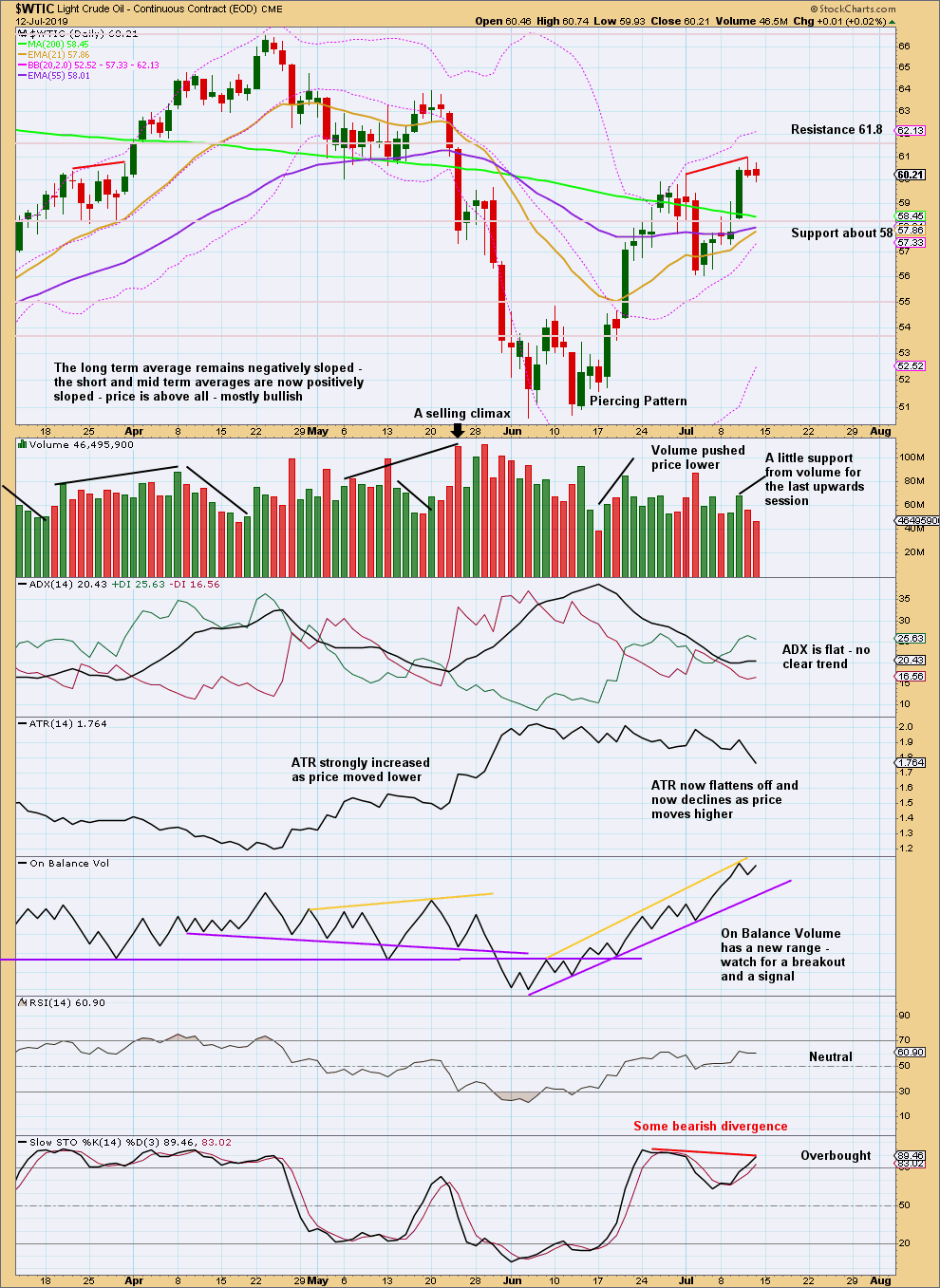
Click chart to enlarge. Chart courtesy of StockCharts.com.
The upwards bounce exhibits some weakness with declining volume and ATR. Look for next resistance about 61.8.
At this stage, there is no evidence that the upwards bounce is over. A bearish candlestick pattern has not yet printed.
—
Always practice good risk management as the most important aspect of trading. Always trade with stops and invest only 1-5% of equity on any one trade. Failure to manage risk is the most common mistake new traders make.

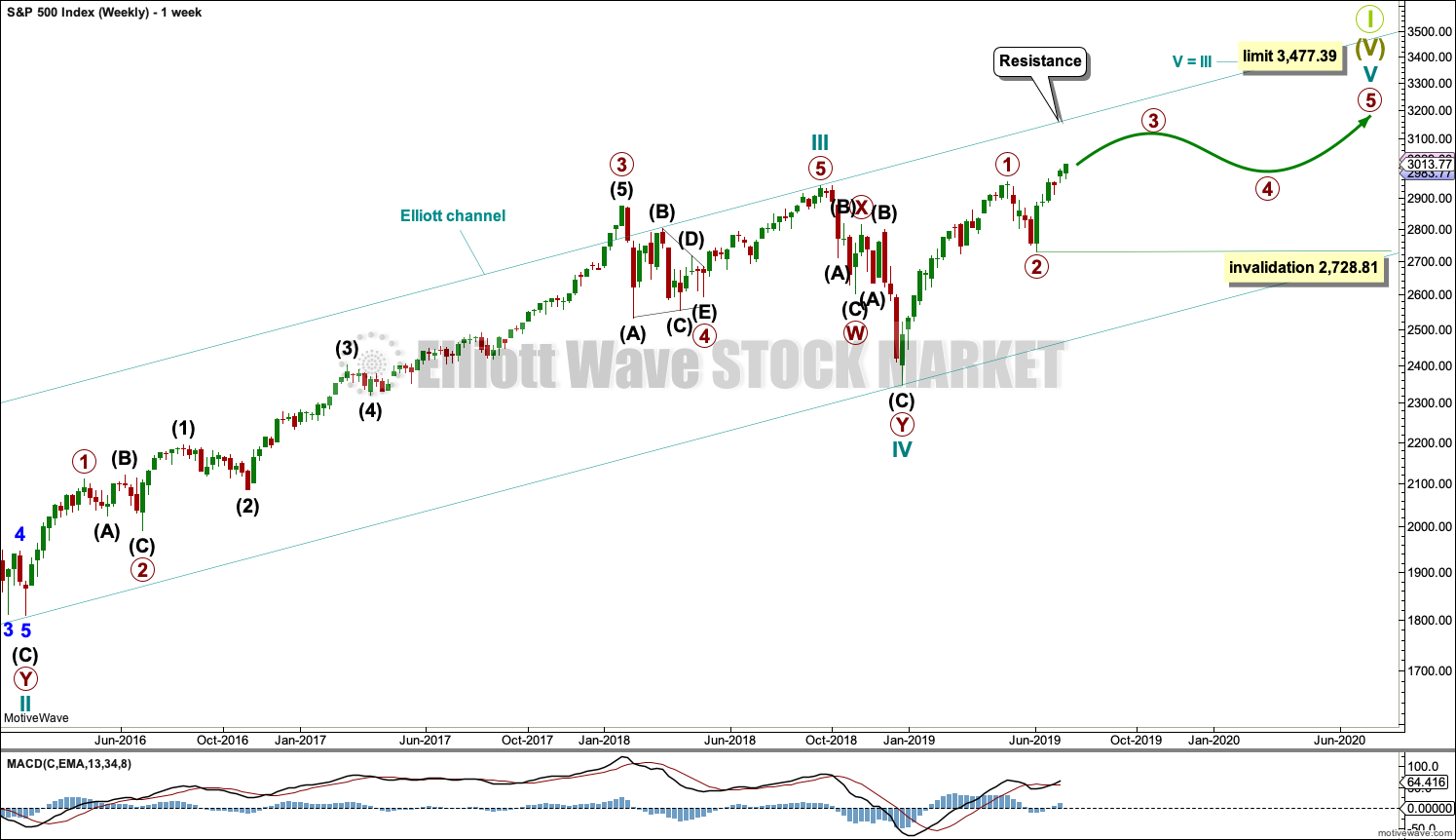
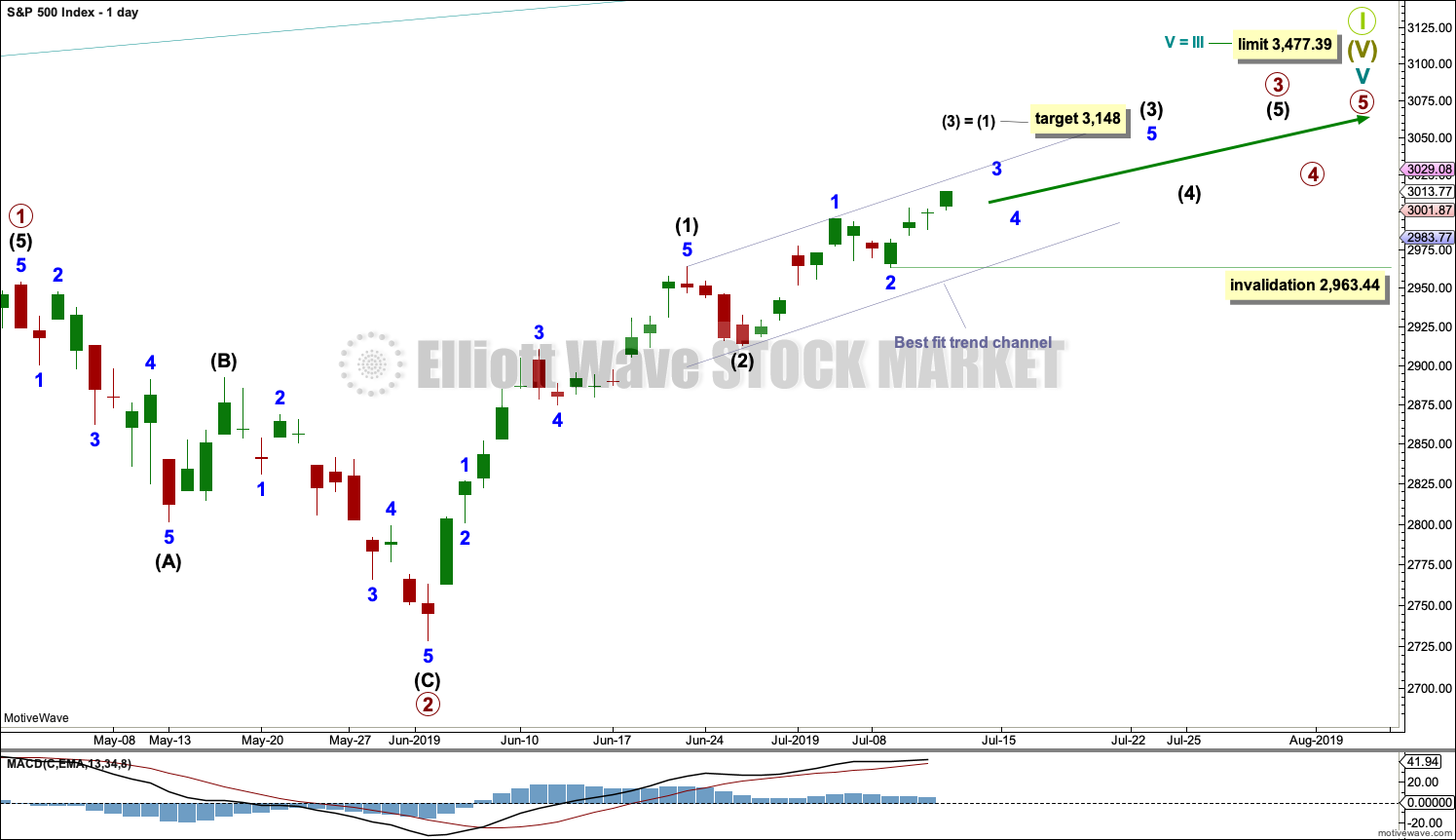
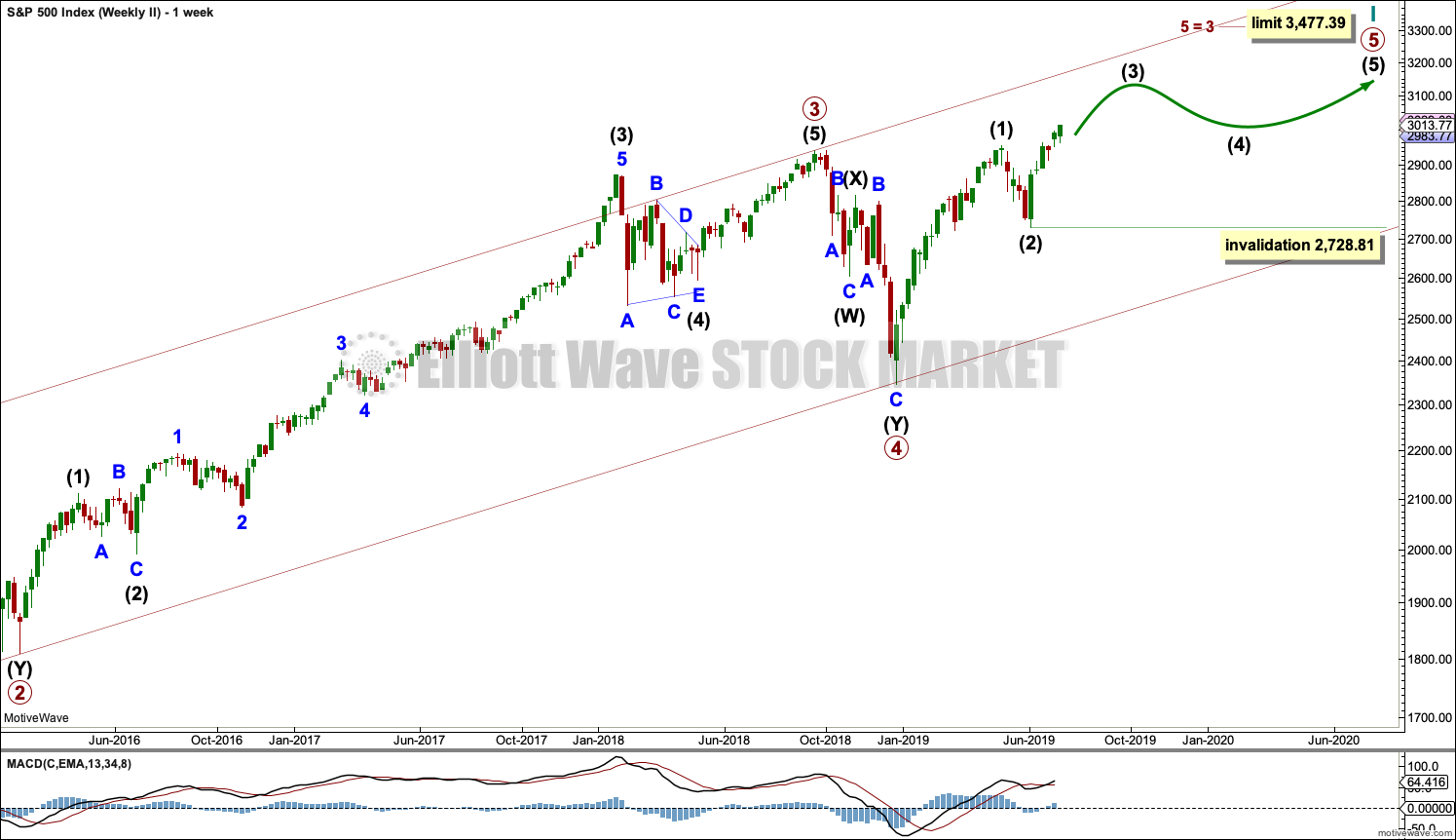
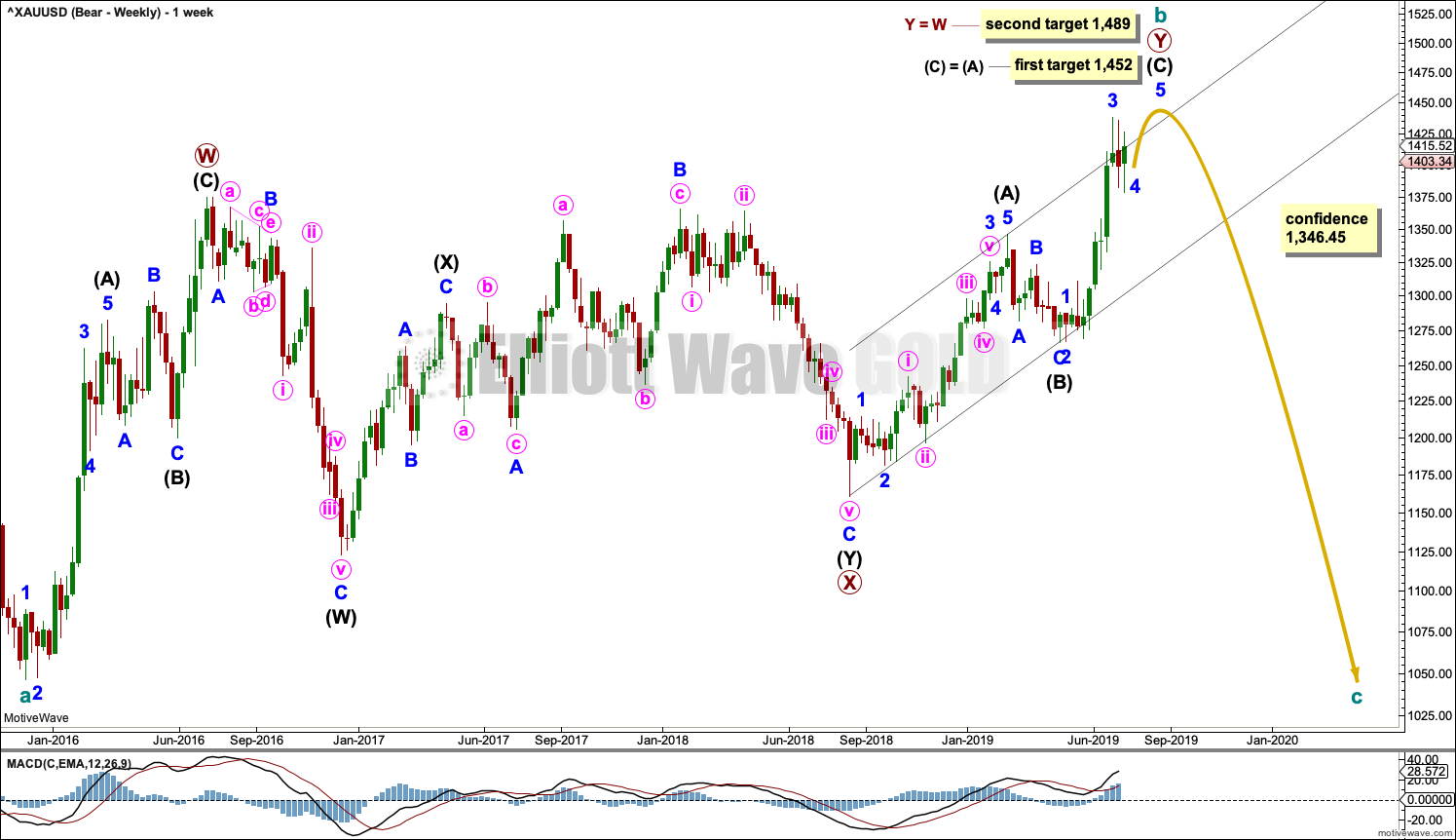
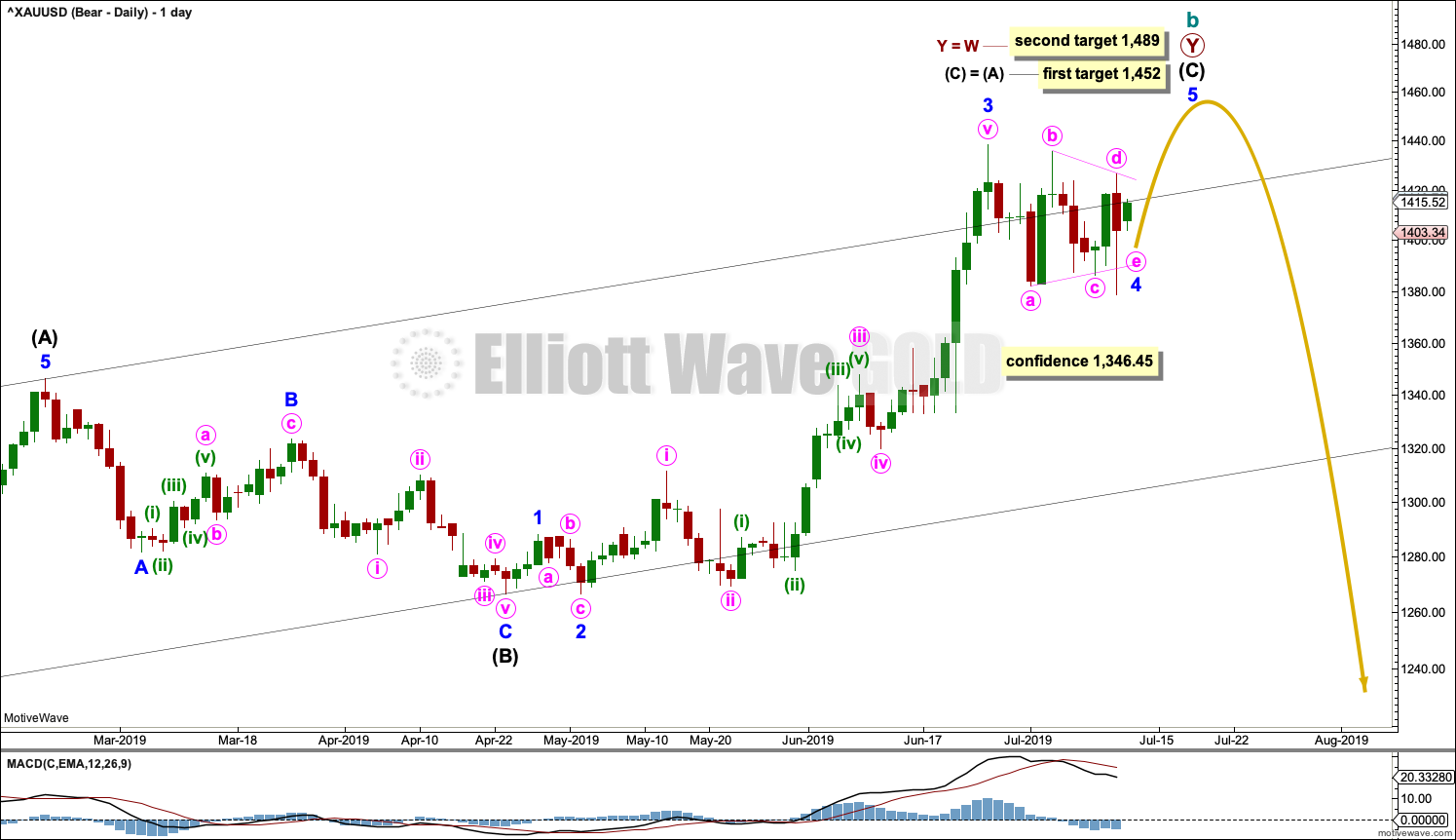
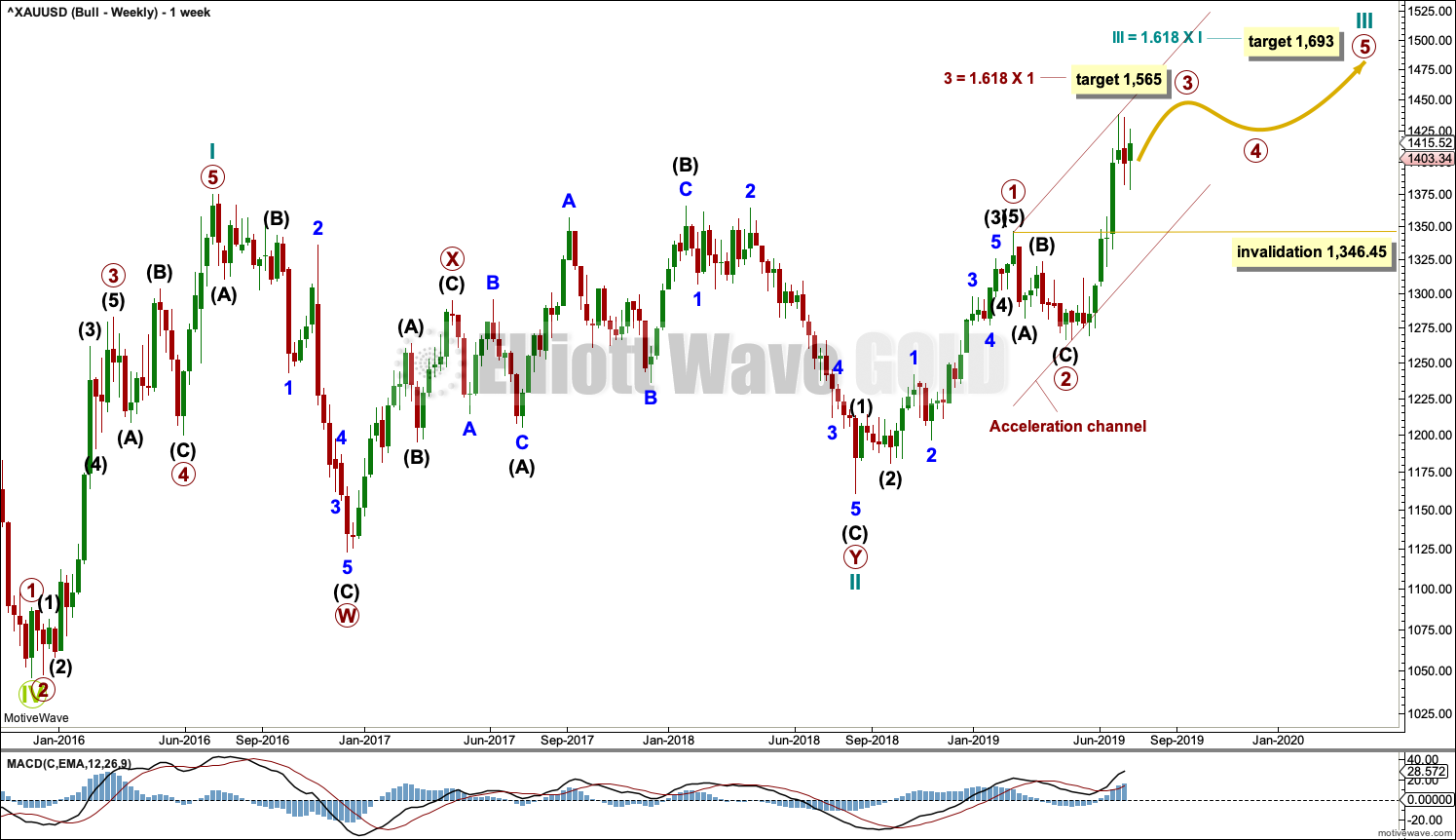
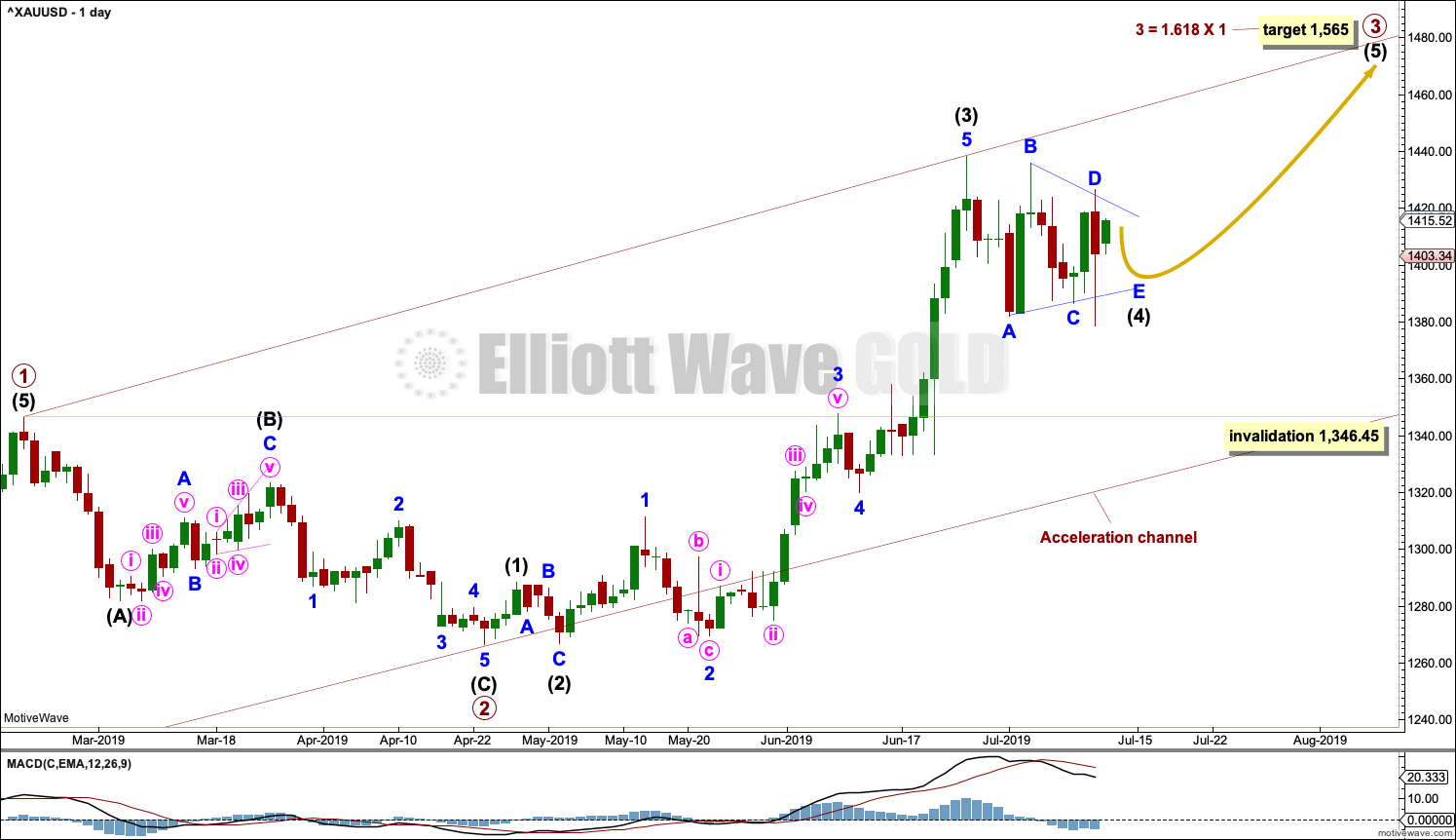
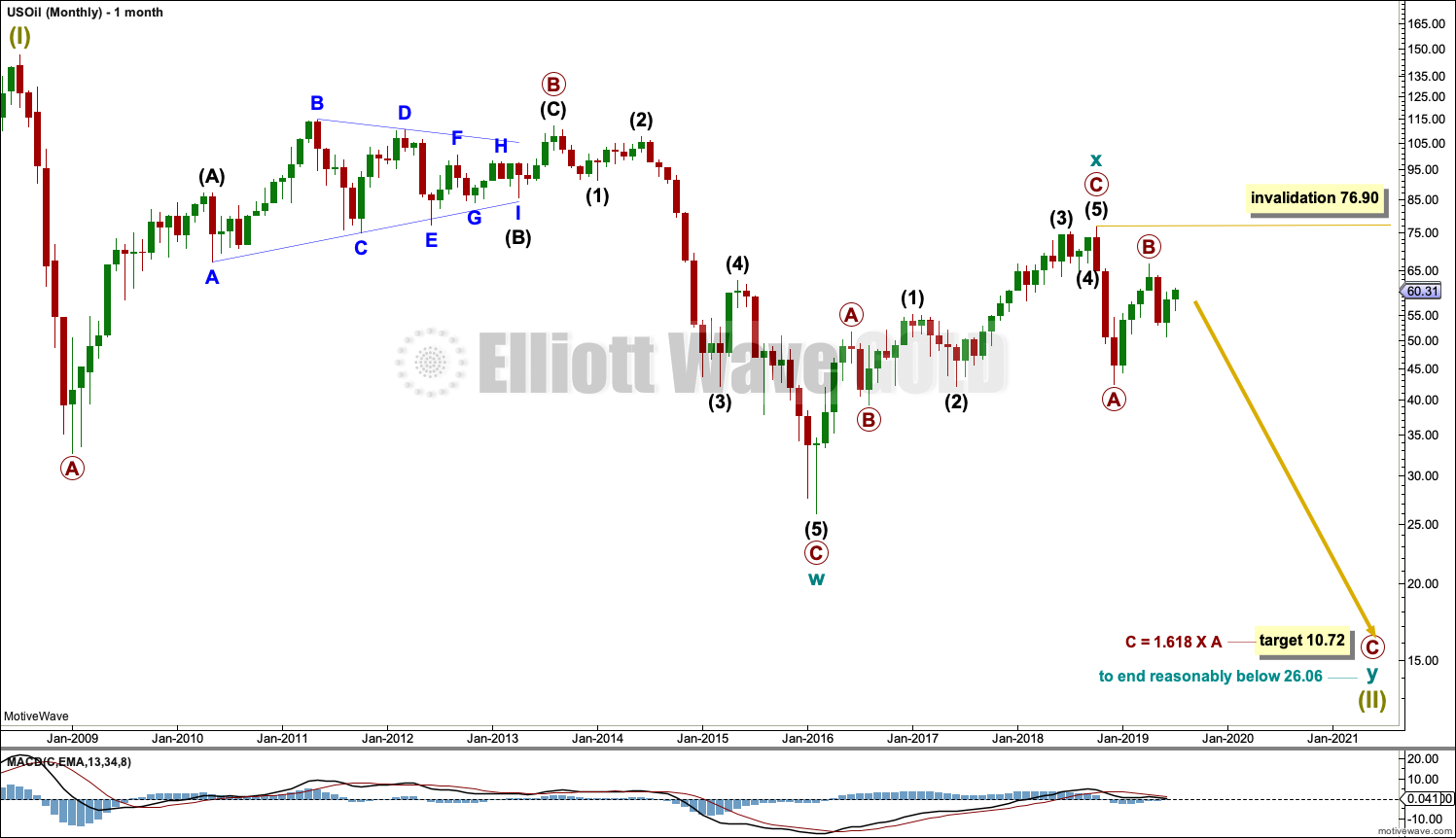

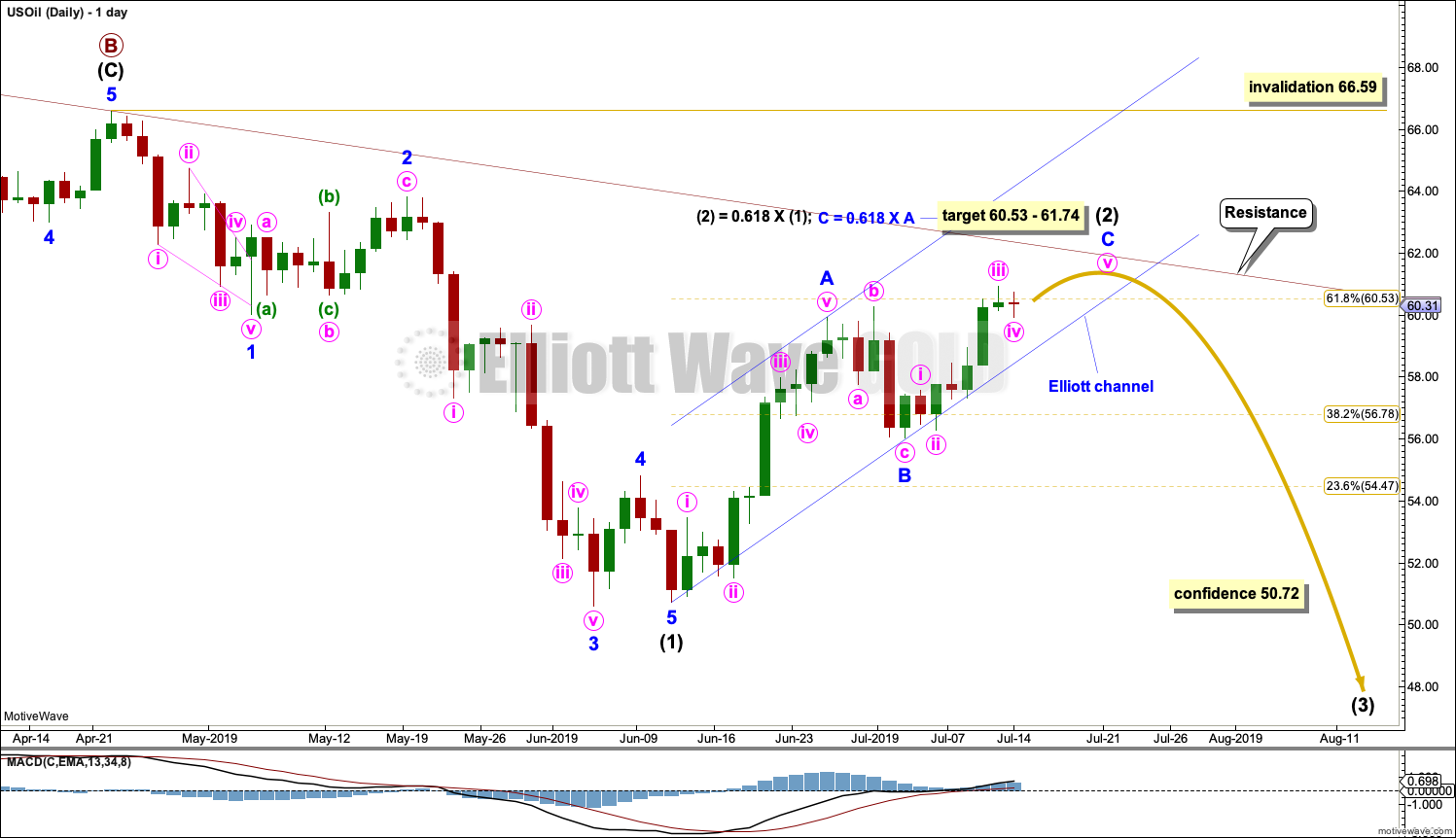
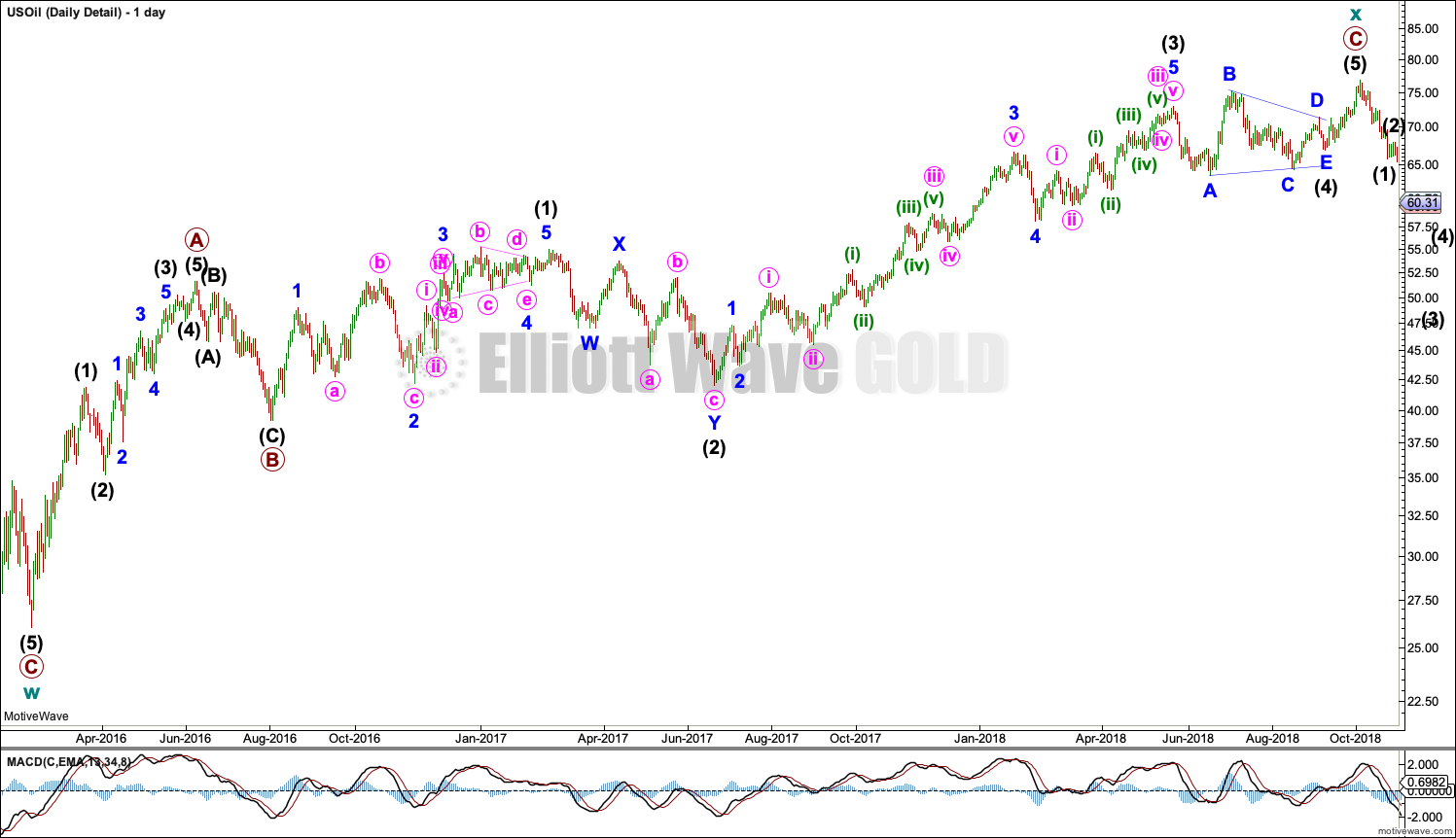
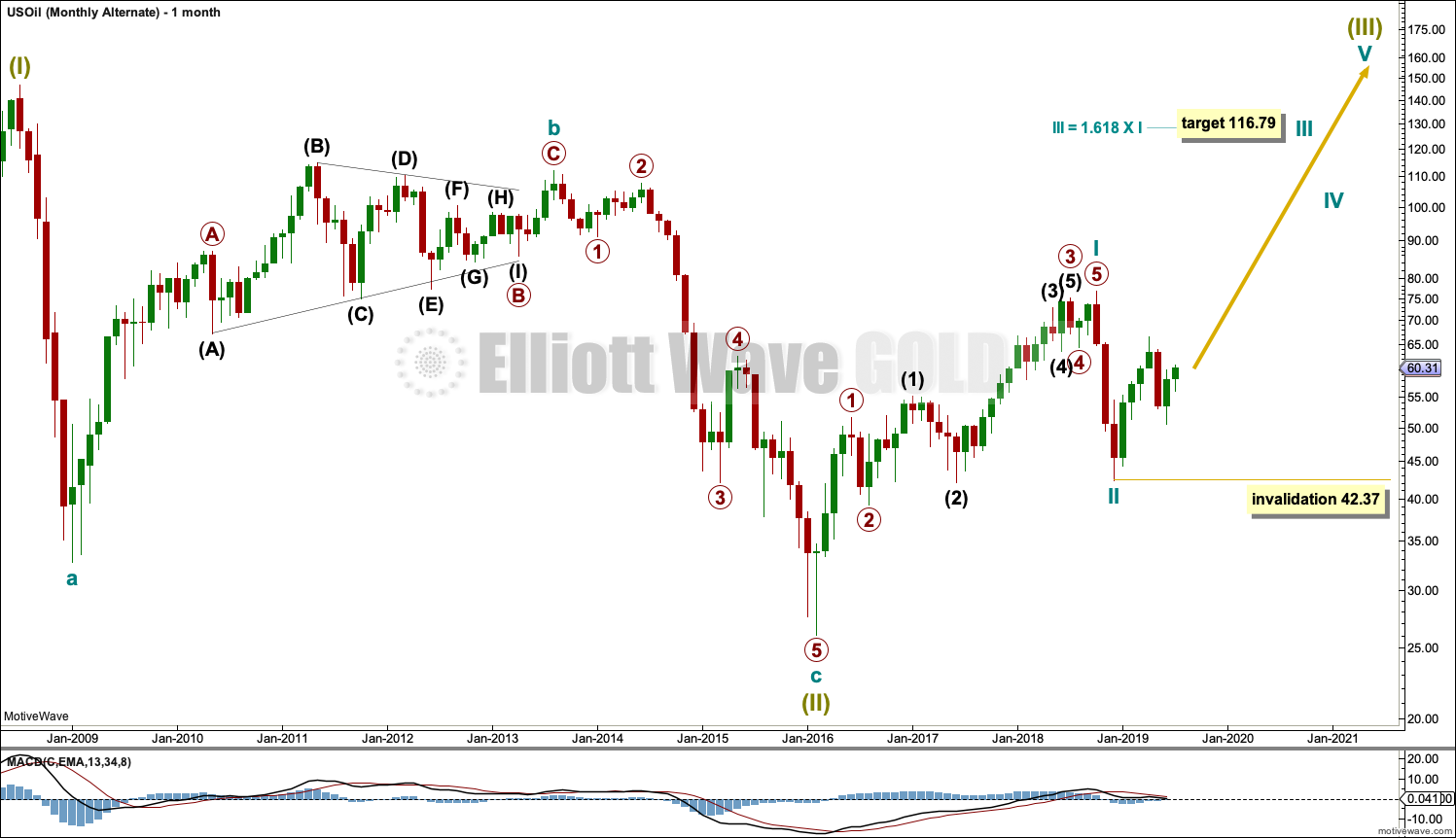
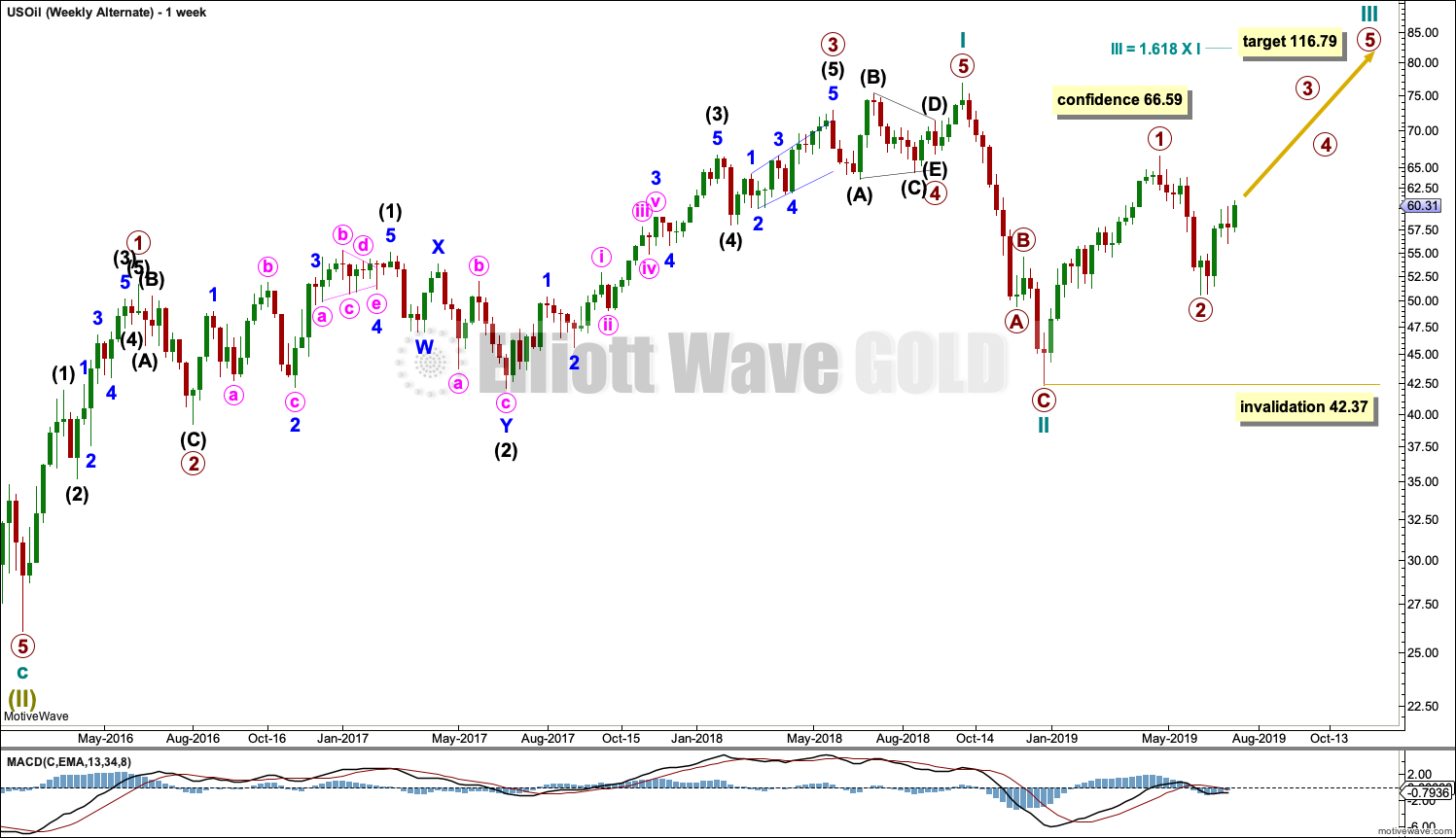
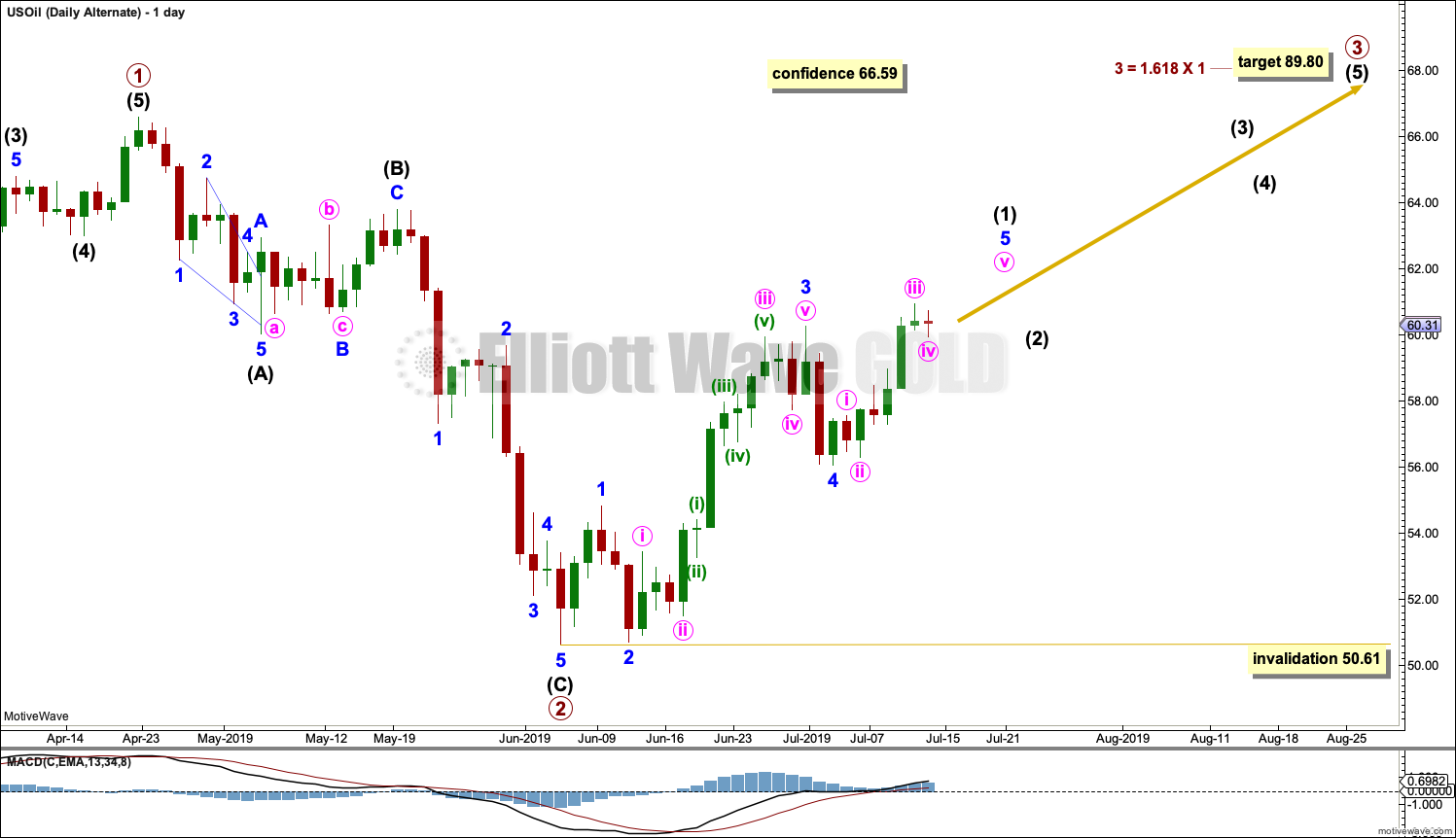
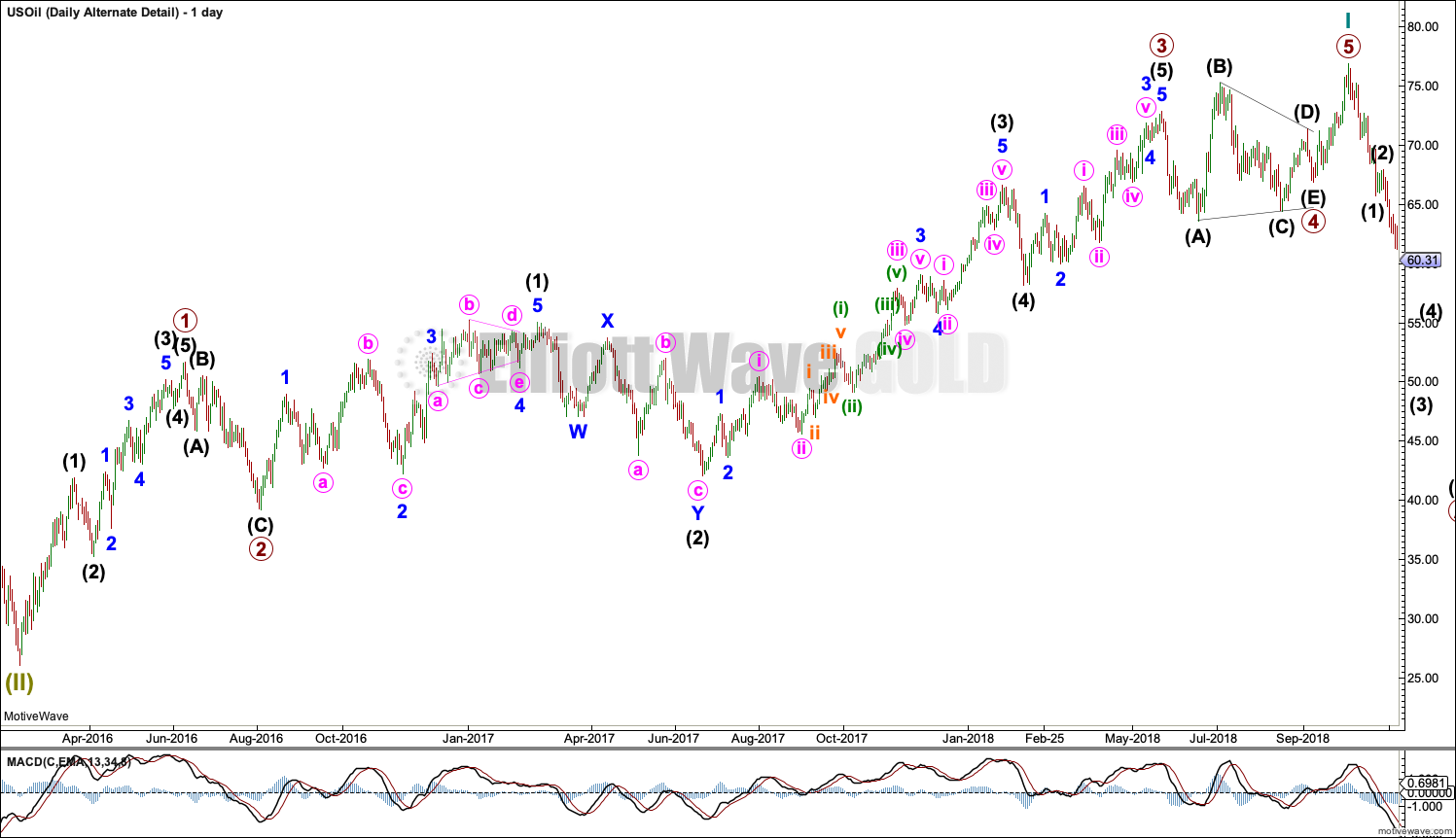
Hi Lara, do we have (in your opinion) a completed initial impulse wave to the downside in oil?
I don’t think so, but almost. But then, as we’ve just seen, I was expecting a final high to complete a five wave structure up for minor C and that didn’t happen so…
Anyway, updated chart of how I’m seeing Oil today for you.
For gold both bull and bear counts:
The fourth wave triangle is now complete. An upwards breakout is underway.
Hi Lara,
It looks like the last piece of the precious metals puzzle is in place… Silver is surging… The strength in Silver mining stocks are telling me that the Gold and Silver bear markets are over.
Cheers,
Mathieu
“the Gold and Silver bear markets are over”
Possibly. Maybe not. Both still have bearish counts, although their probability is declining.
For the oil traders; interesting chart from ECRI/Real Vision… Confirming Lara’s bearish oil outlook…